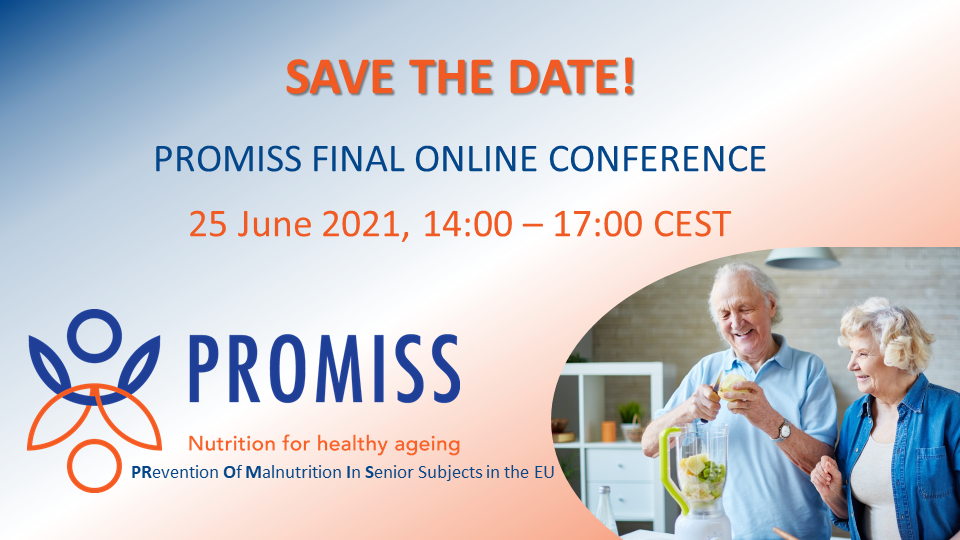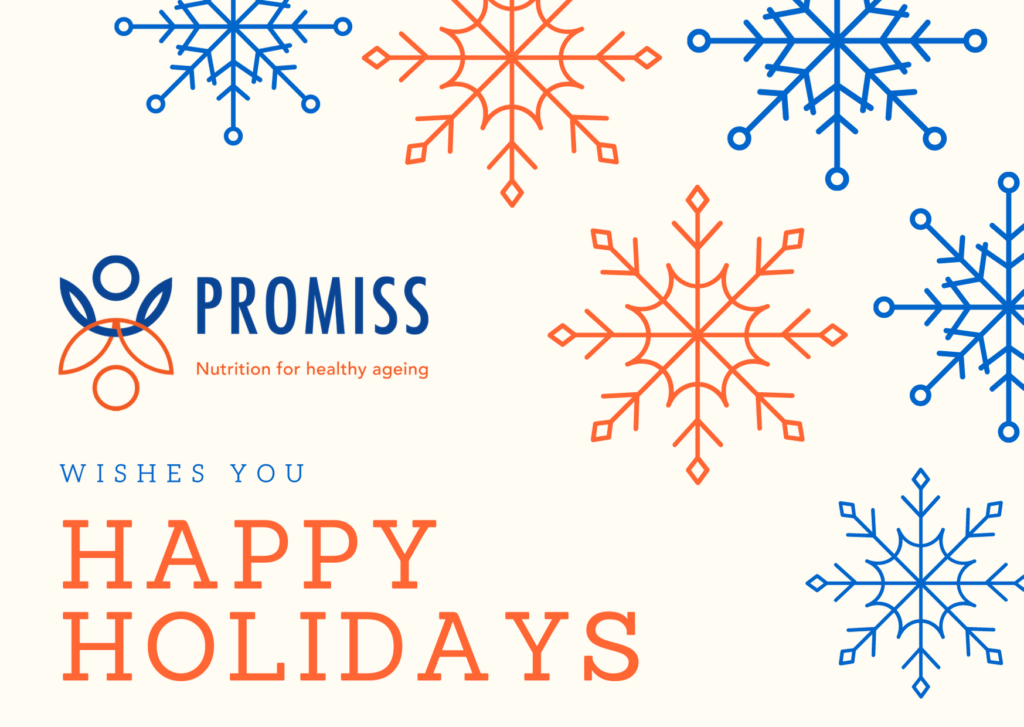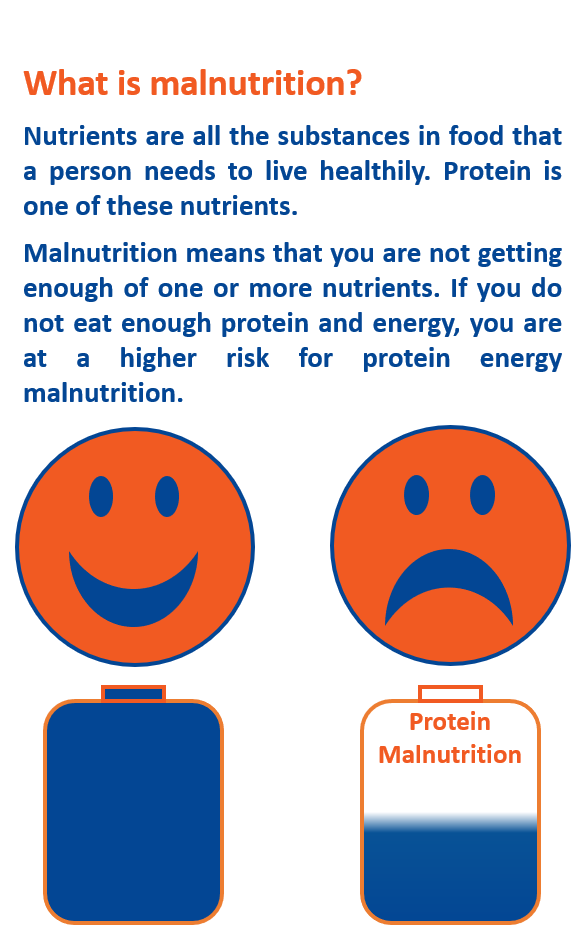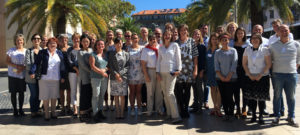Actualités (en anglais)
It is now possible to make the recordings of our final event available to the wide public!
Click here to retrieve all the excellent contents and good memories of PROMISS!
2017
- Fluitman, KS et al. (2017) The intestinal microbiota, energy balance, and malnutrition: emphasis on the role of short-chain fatty acids
- Houston, DK et al. (2017) Protein Intake and Mobility Limitation in Community-Dwelling Older Adults: the Health ABC Study
- Van der Meij, B et al. (2017) Poor Appetite and Dietary Intake in Community-Dwelling Older Adults
2018
- Granic, A et al. (2018) Low protein intake, muscle strength and physical performance in the very old: The Newcastle 85+ Study
- Medonca, N et al. (2018) Prevalence and determinants of low protein intake in very old adults: insights from the Newcastle 85+ Study
- Hengeveld, L et al. (2018) Prospective associations of poor diet quality with long-term incidence of protein-energy malnutrition in community-dwelling older adults: the Health, Aging, and Body Composition (Health ABC) Study
- Fluitman, KS et al. (2018) Potential of butyrate to influence food intake in mice and men
- Wijnhoven, HAH et al. (2018) Development and validation of a short food questionnaire to screen for low protein intake in community-dwelling older adults: The Protein Screener 55+ (Pro55+)
- Mendonca, N et al. (2018) Protein Intake and Disability Trajectories in Very Old Adults: The Newcastle 85+ Study
2019
- Hengeveld, L et al. (2019a) Comparison of protein intake per eating occasion, food sources of protein and general characteristics between community-dwelling older adults with a low and high protein intake
- Van Ballegooijen, AJ et al. (2019) Daily sedentary time and physical activity as assessed by accelerometry and their correlates in older adults
- Granic, A et al. (2019) Effects of dietary patterns and low protein intake on sarcopenia risk in the very old: The Newcastle 85+ study
- Hung, Y et al. (2019) Appetite and Protein Intake Strata of Older Adults in the European Union: Socio-Demographic and Health Characteristics, Diet-Related and Physical Activity Behaviours
- Van der Lubbe, LM et al. (2019) Designing a system with persuasive communication to improve diet compliance for elderly users
- Mendonca, N et al. (2019a) Contribution of protein intake and its interaction with physical activity to transitions between disability states and to death in very old adults: the Newcastle 85+ Study
- Hengeveld, L et al. (2019b) Prospective Associations of Diet Quality With Incident Frailty in Older Adults: The Health, Aging, and Body Composition Study
- Grasso, A et al. (2019) Older Consumers’ Readiness to Accept Alternative, More Sustainable Protein Sources in the European Union
- Fluitman, KS et al. (2019) The Association of Olfactory Function with BMI, Appetite, and Prospective Weight Change in Dutch Community-Dwelling Older Adults
- Kiesswetter, E et al. (2019) Oral health determinants of incident malnutrition in community-dwelling older adults
- Mendonca, N et al. (2019b) Protein intake and transitions between frailty states and to death in very old adults: the Newcastle 85+ study
2020
- Kiesswetter, E et al. (2020) Association of oral health with body weight: a prospective study in community-dwelling older adults
- Reinders, I et al. (2020a) Two dietary advice strategies to increase protein intake among community-dwelling older adults: A feasibility study
- Rooijackers, TH et al. (2020) Protein intake pattern over the day and its association with low total protein intake in Dutch community-dwelling older adults
- Elstgeest, LEM et al. (2020) Sex-and race-specific associations of protein intake with change in muscle mass and physical function in older adults: the Health, Aging, and Body Composition (Health ABC) Study
- Hengeveld, L et al. (2020) Prevalence of protein intake below recommended in community‐dwelling older adults: a meta‐analysis across cohorts from the PROMISS consortium
- Van der Lubbe, L et al. (2020) Integrating gamification into a system to improve diet compliance for elderly users
- Chang, M et al. (2020) A poor appetite or ability to eat and its association with physical function amongst community-dwelling older adults: age, gene/environment susceptibility-Reykjavik study
- Reinders, I et al. (2020b) Effectiveness and cost-effectiveness of personalised dietary advice aiming at increasing protein intake on physical functioning in community-dwelling older adults with lower habitual protein intake: rationale and design of the PROMISS randomised controlled trial
2021
- Grasso, A et al. (2021a) Protein for a Healthy Future: How to Increase Protein Intake in an Environmentally Sustainable Way in Older Adults in the Netherlands
- Broeckhoven, I et al. (2021) Consumer valuation of carbon labeled protein-enriched burgers in European older adults
- Tsai, LT et al. (2021) Associations between objectively measured physical activity, sedentary behaviour and time in bed among 75+ community-dwelling Danish older adults
- Visser, M et al. (2021) Protein Knowledge of Older Adults and Identification of Subgroups with Poor Knowledge
- Fluitman, K et al. (2021) Poor Taste and Smell Are Associated with Poor Appetite, Macronutrient Intake, and Dietary Quality but Not with Undernutrition in Older Adults
- Grasso, A et al. (2021b) Understanding meat consumption in later life: A segmentation of older consumers in the EU
- Mendonca, N et al. (2021) Low protein intake, physical activity and physical function in European and North American community-dwelling older adults: a pooled analysis of four longitudinal aging cohorts
- van der Lubbe, L et al. (2021) Experiences with using persuasive technology in a diet trial for older adults
- Lourida, I at al. (2021), Association of daily physical activity and sedentary behaviour with protein intake patterns in older adults: a multi-study analysis across five countries
- Hengeveld, L.M et al. (2021), Prospective associations of protein intake parameters with muscle strenght and physical performance in community-dwelling older men and women from the Quebec NuAgge cohort
Am J Clin Nutr. 2021 Apr 6;113(4):972-983. doi: 10.1093/ajcn/nqaa360.
Dietary protein has been related to muscle function in aging. Beyond total intake, parameters such as protein distribution across meals might also be important.
The research aimed to examine prospective associations of different protein intake parameters with muscle strength and physical performance in community-dwelling older men and women.
In total, 524 men and 574 women aged 67-84 y at baseline (T1) were followed annually for 3 y (T2, T3, T4). Outcomes included handgrip strength (kPa), knee extensor strength (kg), and physical performance (Timed Up and Go, s) at T4, and their 3-y changes (T4 minus T1). Protein intake parameters were assessed using nine 24-h recalls collected over 3 y (T1, T2, T3) and included daily total intake (g/d), number of protein-providing meals and snacks, and protein distribution across meals (expressed as CV). Associations were examined by multivariable linear regression models including all protein intake parameters simultaneously. Also, the optimal protein dose (g) per meal for the maximum effect size of total daily intake was determined.
Results: Higher daily protein intake was associated with better knee extensor strength and physical performance at T4 in both sexes and less physical performance decline in women. Optimal protein doses per meal were 30-35 g in men and 35-50 g in women for these outcomes. In men, more uneven protein distribution was associated with better physical performance at T4 and less handgrip strength decline. In women, a higher number of protein-providing snacks was associated with better handgrip strength and knee extensor strength at T4 and less handgrip strength decline. In neither sex was number of protein-providing meals associated with outcomes.
Conclusions: Higher daily protein intake, up to 30-50 g protein/meal, may contribute to better knee extensor strength and physical performance in generally well-functioning older men and women. More aspects of protein intake may contribute to muscle strength and physical performance than solely the daily quantity, notably the protein dose per meal.
Access the full article here.
Issued from the cooperation between PROMISS and EFAD, we are pleased to announced that the High-Protein Main Meals Recipe Booklet is available!
It is equally accessible via the EFAD website following this link: https://www.efad.org/en-us/endiets/recipe-competition-april-2021/%CE%B7igh-protein-recipe-booklet/
Ilianna Lourida, Jolanda M.A. Boer, Ruth The, Ngaire Kerse, Nuno Mendonça, Anna Rolleston, Stefania Sette, Heli Tapanainen, Aida Turrini, Suvi M. Virtanen, Marjolein Visser, Carol Jagger
Being physically active and eating enough protein can slow decline in muscle strength and physical function, and therefore contribute to healthy ageing. We wanted to investigate if there was a relationship between being physically active or sedentary and the timing of protein intake in older adults living in the community. We used data from five studies (Newcastle 85+ Study, UK; LiLACS, New Zealand; DNFCS, the Netherlands; FINDIET, Finland; INRAN-SCAI, Italy) including more than 3300 participants. We found that older adults with higher levels of physical activity were more likely to eat more meals containing protein, and had higher total protein intake during the day, although this seemed to be due to greater overall food consumption. Protein distribution was uneven across meals with most protein consumed at midday and evening meals, and this was true in both physically active and sedentary older adults. Overall, our results suggest that patterns of protein intake in older adults do not seem to differ by physical activity or sedentary behaviour levels.
Read the last two important papers of the PROMISS project!
Do not hesitate to contact the team PROMISS.PO@vu.nl for more information!
Laura van van der Lubbe, Michel Klein, Marjolein Visser, Hanneke Wijnhoven, Ilse Reinders
PETRA 2021: The 14th PErvasive Technologies Related to Assistive Environments Conference
Part of the PROMISS diet trial was the persuasive technology sub study. For this sub study we designed a tablet application and foodbox that 48 participants could using during their diet trial for diet tracking. We studied the adherence (commitment to using the technology), protein intake, experience of dietary advice and technology, and the effect of gamification in our app on the protein knowledge of users. This paper presents the most important results.
Participants are positive about the tablet application, but negative about the foodbox. On average, participants used the tablet actively for 133 days. Participants stay committed during their use, 83% of the days that they used the tablet for were active days. We did not find a significant change in the protein intake of our participants, compared to participants without a tablet.
Based on these results we conclude that a diet tracking application designed for older adults is a feasible and appreciated tool to use within a dietary intervention study in older persons.
Also available in German, Italian, French, Spanish, Dutch, Finnish, Hungarian, Polish, Portuguese, Romanian, Swedish, Czech, Danish and Greek.
The PROMISS (PRevention Of Malnutrition In Senior Subjects) project presented its results in a hybrid conference on 25 June 2021. With the European population growing older, the challenge is to age healthily and actively. However, in Europe, between 20-50% of all older adults living at home are malnourished or at risk of protein energy malnutrition.
Based on the outcomes of the European-funded research project PROMISS (PRevention Of Malnutrition In Senior Subjects), it was concluded that for optimal physical functioning, older adults should eat at least 1.0 gram protein/kg bodyweight/day. However, more than half of the older adults does not meet this requirement. Based on these and other results PROMISS developed optimized, sustainable and evidence-based dietary and physical activity recommendations to prevent malnutrition and support active and healthy ageing.
Recommendations
Based on scientific evidence, PROMISS recommends the following for older adults on:
Protein intake
- Consume more than 1.0 g protein per kg body weight per day as it benefits physical function;
- Consume at least 30 g of protein in one meal per day and, if possible, in two meals per day;
- Use protein-enriched food products to increase protein intake when appetite is poor or with a vegetarian diet;
- Increase protein intake gradually and use products with a high protein density, and especially high protein drinks, to avoid feelings of fullness and bloating.
- Older adults, their dietitians or health professionals should evaluate the protein intake with the Protein Screener at proteinscreener.nl.
A more sustainable diet
- Eat more plant-based protein such as legumes, cereals, nuts and seeds;
- It is not necessary to go completely vegan or vegetarian;
- Eat less animal based protein (such as beef, lamb, and processed meats) and choose chicken and pork – if meat is eaten;
- Fish should not be eaten more than once a week;
- If fish is eaten, eco-labels on certified fish products such as the blue Marine Stewardship Council (MSC) logo, and Aquaculture Stewardship Council (ASC) logo should be considered.
Physical activity
- Be physically active for at least 30 minutes per day, as it benefits physical function and quality of life, and helps to prevent frailty and protein-energy malnutrition;
- The longer, the more frequent, and/or the more intensive older adults are physically active, the more their health will benefit;
- Engage in activities that strengthen the muscles and bones, for example resistance training;
- Sedentary behaviour should be reduced as much as possible, as this lowers the risk of functional decline and frailty.
About PROMISS
PROMISS (PRevention Of Malnutrition In Senior Subjects) is a multidisciplinary international consortium that performed research on the prevention of malnutrition in older people living at home. The project has received funding from the European Union’s Horizon 2020 research and innovation programme, grant n° 678732.
More information about the project, scientific publications, practical tools, and explanatory videos about protein can be found on the PROMISS website: www.promiss-vu.eu
Recommendations and supporting materials for different target audiences are also available:
- Older adults (available in multiple languages)
- Health professionals (available in English and German)
- Dietitians and nutritionists (available in English and Dutch)
- Policy makers (in English)
- Food industry and SMEs (in English)
For more information or questions about the project please contact the project office at promiss.po@vu.nl.
PROMISS organises its final conference online on 25 June 2021 from 14:00 to 17:00 CEST. The conference will provide the opportunity to learn more about the importance of protein for older people, the PROMISS findings and evidence-based recommendations developed in the project. It will foster engagement between the PROMISS researchers and the target audiences and allow for interactive virtual exchanges.
A roundtable discussion with input from international experts will assess the importance of protein for older people. This will be followed by a plenary session on optimal protein intake for older people living at home. Three break-out sessions on specific protein-related topics are then held – conference participants get the chance to participate in two out of three as the same session will be run twice (also see programme below for details).
- Session 1: Eating protein in a environmentally friendly way
- Session 2: Older adults’ perspectives on protein – consumer insights
- Session 3: Supporting older adults to increase their protein intake
Registration: register for free (click here)
Who should attend:
- Researchers interested in protein malnutrition, and sustainable diets
- Health care professionals interested in supporting their patients in increasing their protein intake
- Dietitians and nutritionists
- Older people with an interest in healthy food and healthy ageing
- Policy makers working on nutrition, healthy ageing and sustainable food policies
- Food industry and small and medium-sized enterprises interested in developing protein (en)rich(ed) products
Programme
14.00 Welcome Marjolein Visser, Professor of Nutrition and Health at Vrije Universiteit Amsterdam
14.05 PROMISS – the importance of protein for older people
Roundtable discussion with input from international experts
- Alfonso Cruz Jentoft, Professor of Geriatrics at Universidad Europea de Madrid
- Tommy Cederholm, Professorof of Clinical Nutrition at Uppsala University
- Dorothee Volkert, Professor of Clinical Nutrition in Old Age at Friedrich-Alexander-Universität
- Jürgen Bauer, Professor of Geriactric Medicine at Universität Heidelberg
14.20 Optimal protein intake for community-dwelling older adults
Marjolein Visser, Professor of Nutrition and Health at Vrije Universiteit Amsterdam
Plenary Session
What is the optimal protein intake for older people in order to age healthily? There will be a brief introduction to the current protein intake among older people and the relationship between protein, muscles and loss of function in ageing.
15:00 Explanation of the 3 breakout sessions + break
15.15 Breakout session 1-3, round 1
- Session 1: Eating protein in a environmentally friendly way: What is the role of food production on the environment, what are sustainable sources of protein and how can you eat sustainably? You will get answers to these and other questions.
- Session 2: Older adults’ perspectives on protein – consumer insights: We will look at older people’s knowledge of protein, what their preferences are when it comes to protein sources and whether there are differences between different groups.
- Session 3: Supporting older adults to increase their protein intake: Questions that will be addressed in this session are: How do you calculate the right protein requirement for different people, what are the potential risks of more protein and what tools are available to help older people make good choices when it comes to protein?
15.45 Break
15.50 Session 1-3, round 2
16.20 Protein quiz
The quiz will test your knowledge of protein and will be presented live. Will you be the one to win one of the great prizes?
16.30 Wrap-up and concluding words by the PROMISS Coordinator
16.45 PROMISS video
Highlights of the PROMISS experience and an overview of further information materials.
Programme for download (click here)
Nuno Mendonça, Linda M Hengeveld, Marjolein Visser, Nancy Presse, Helena Canhão, Eleanor M Simonsick, Stephen B Kritchevsky, Anne B Newman, Pierrette Gaudreau, Carol Jagger
American Journal of Clinical Nutrition 2021
Dietary protein may slow the decline in muscle mass and function with aging, making it a sensible candidate to slow down or even prevent disability progression. At present, studies providing reliable estimates of the association between protein intake and physical function, and its interaction with physical activity, in community-dwelling older adults are lacking. We wanted to investigate the longitudinal relationship between protein intake and physical function, as well as how the results varied with different physical activity levels. For this we used individual participant data from four cohorts in the PROMISS consortium (Health ABC, NuAge, LASA and Newcastle 85+) with more than 5700 participants living in the community and followed up to almost 9 years. We found that higher daily protein intake may reduce physical function decline not only in older adults with protein intake below the current recommended dietary allowance of 0.8 grams/kg bodyweight/day, but also in those with a protein intake that is already considered sufficient, i.e. above and beyond the 0.8 grams/kg bodyweight/day. This dose-dependent association was observed for all levels of physical activity, suggesting that the results on the association between protein intake and physical function do not change by physical activity level.
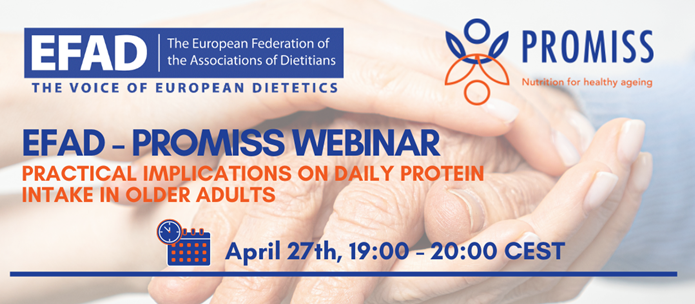
PROMISS partner EFAD – the European Federation of the Associations of Dietitians – will organise a webinar on the « practical implications on daily protein intake in older adults » on 27 April, at 19:00 CET.
The webinar features contributions by PROMISS partners Ilse Reinders (Vrije Universiteit Amsterdam), Christine Yung Hung (University of Ghent) and Riikka Niskanen (University of Helsinki) and is moderated by Amalia Tsagari, ESDN Older Adults.
During this webinar, our speakers will share their practical insights and research experience relating to the protein intake and nutritional needs of older adults. This webinar aims to provide all the latest information and research outcomes of the PROMISS Research Project about the Practical implications on daily protein intake in older adults and the risk groups.
Free registration is now open (click here)
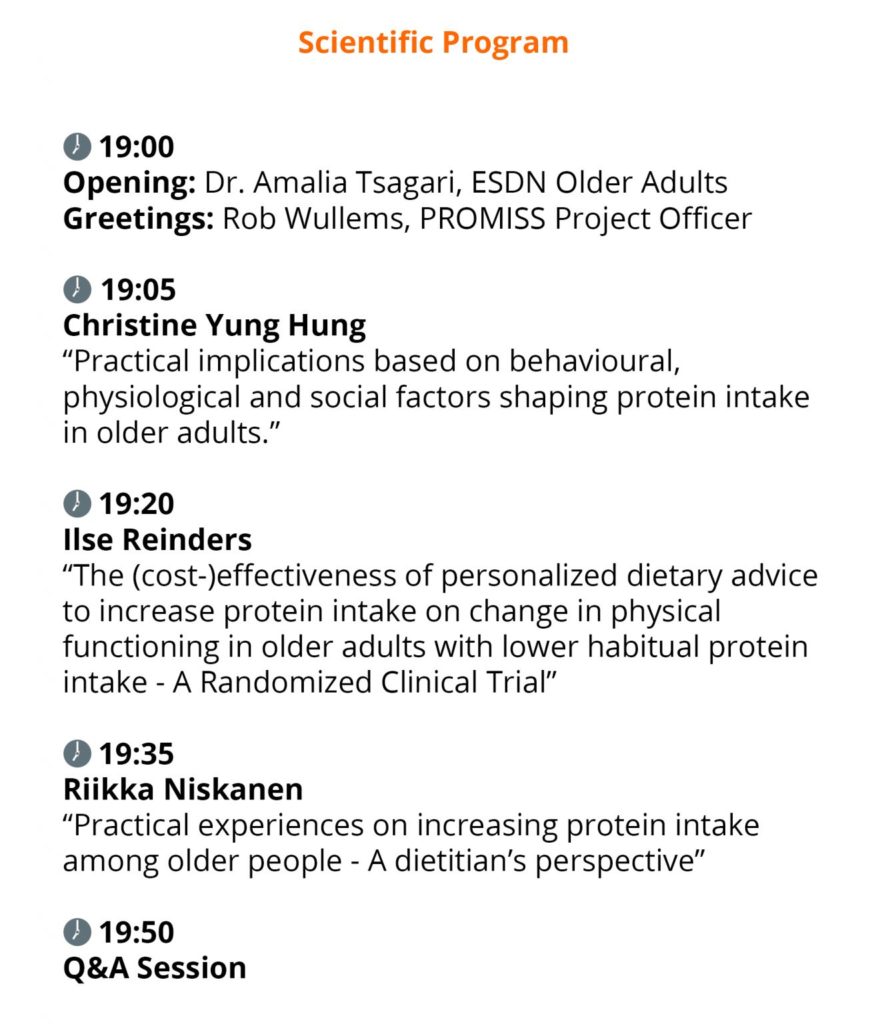

In the context of disseminating PROMISS findings, PROMISS partner EFAD – the European Federation of the Associations of Dietitians – supported by the European Network of Dietetic Students (ENDietS) organizes a high-protein meal for older adults recipe competition.
Recipe submissions that fulfil all the criteria will be published in a recipe book that will inspire Older Adults to create healthy high-protein meals.
This competition is open only to Dietitians/ Nutritionists and/or Dietetic Students. The competition is open worldwide.
Members of the Executive Team of ENDietS are not eligible to participate in the competition, while National Key Contacts can participate.
One individual has the right to submit 1-3 recipes, multiplying their chances to win.
Entries will be accepted by email (endiets@efad.org) starting on 5th April 2021 at 00:00 CEST and ending 26th April 2021 at 23:59 CEST.
The winners will be announced by the 1st of June 2021.
How to enter the competition:
- Read this booklet that will help you and guide you through your recipe submission (click here).
- You have to agree to the rules on pg. 11 before you submit your recipe.
- Download this template (click here), create your recipe accordingly, and save it as a PDF file.
- Submit by sending the PDF file/s and the photo/s (optional) to endiets@efad.org, before the deadline with the subject: “High-Protein Meal Recipe Competition + your name”
PROMISS member ESPEN is organising a webinar to share key PROMISS scientific and clinical findings in a dedicated webinar with free access upon registration.
When: 15 April 2021, 16:00 – 17:30 CET
Where: Online
Registration: for free (click here)
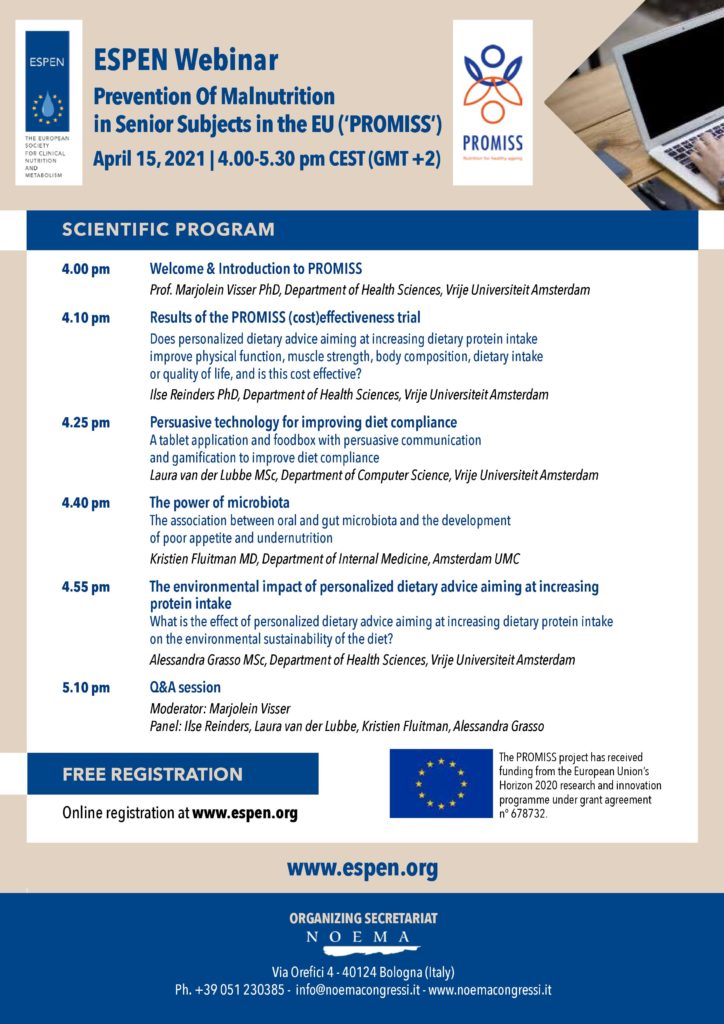
Alessandra C.Grasso, YungHung, Margreet R.Olthof, Ingeborg A.Brouwer, WimVerbeke
Food Quality and Preference, 2021, 104242, ISSN 0950-3293
Eating adequate amounts of protein is important for the maintenance of health, independence, and quality of life especially for older adults. While meat is an important source of protein, it holds the most weight in the environmental impact of EU diets. This study aimed to gain a deeper understanding of meat consumption behavior among older adults by identifying and comparing different groups of older adults with differing patterns of meat consumption and liking.
A survey was conducted among 2,500 community-dwelling older adults aged 65+ years in Finland, Poland, Spain, the Netherlands, and the United Kingdom. Three groups of older consumers were identified: heavy meat consumers, medium meat consumers, and light meat consumers. The groups differed significantly in several socio-demographics and background characteristics, appetite, protein intake, attitudes towards meat and plant-based ‘meat’ substitutes, and liking of protein sources other than meat. Health and sustainability food choice motives were important determinants for being classified as a medium or light meat consumer compared to a heavy meat consumer whereas food fussiness, sensory appeal, and familiarity were important determinants for being classified as a heavy meat consumer compared to a light meat consumer. Opportunities and barriers to meeting the high protein needs in an environmentally sustainable way and implications for designing dietary strategies to address the unique health and sustainability challenges among older adults in the EU are discussed.
Kristina S Fluitman, Anne C Hesp, Rachel F Kaihatu, Max Nieuwdorp, Bart JF Keijser, Richard G IJzerman, Marjolein Visser
The Journal of Nutrition, 2021 Mar 11;151(3):605-614
As we age, our taste and smell functions deteriorate. This is thought to contribute to poor appetite, decreased food intake, poorer dietary quality, and the development of undernutrition in older adults. In this study, we evaluated whether poor taste and smell were indeed associated with poor appetite, food intake, dietary quality, and the occurrence of undernutrition.
We recruited 359 Dutch older adults over 65 years old from the large, ongoing Longitudinal Aging Study Amsterdam (LASA). We collected all of our data during a single home visit at the participants’ homes between 2017 and 2018. Taste and smell function were measured with objective standardized tests, and were rated subjectively by the participants themselves. Poor appetite, food intake and dietary quality were assessed with two questionnaires: the Council of Nutrition Appetite Questionnaire (CNAQ) and a Food Frequency Questionnaire (FFQ). Undernutrition was defined as either >5% bodyweight loss over the previous 2 years, or a low BMI.
Of our 359 participants, 9.2% had poor taste, 17% had poor smell, 6.1% had poor appetite, and 2.1% suffered from undernutrition. Various associations were found of poor taste or smell with poor appetite, food intake, or dietary quality, but not with undernutrition. Both self-reported poor taste and smell were consistently associated with poor dietary quality.
Taste and smell impairments may have diverse consequences for appetite, food intake, or dietary quality. However, this does not necessarily translate into undernutrition.
Marjolein Visser, Yung Hung, Wim Verbeke
Nutrients 2021, 13, 1006. https:// doi.org/10.3390/nu13031006
About one in four older adults do not eat enough protein. Providing information to older adults about dietary protein might lead to an improvement in protein intake. To optimally provide this information, it is important to know what older adults already know about dietary protein. We measured the knowledge about dietary protein in almost 2000 community-dwelling older Europeans from five countries. Most older adults knew that dietary protein is important for health and muscles. Fewer older adults knew the correct protein content of foods. However, only few older adults were knowledgeable on the recommended protein intake. Overall, about half of the older population had a poor knowledge. Males, those unable to walk for 5 minutes, those not always making their own food decision, and those with a lower income were more likely to have poor knowledge. Furthermore, large knowledge differences were observed between the five countries. We conclude that the level of knowledge about dietary protein can be improved in about half of the older population. Better communication and information about dietary protein is thus needed and should be targeted to the groups with the poorest knowledge.
The Horizon2020 PROMISS project tackles malnutrition with a specific focus on protein-energy malnutrition.
PROMISS makes use of large-scale databases to understand the relationships between food intake, food characteristics, physical activity, the oral and gut microbiota, and poor appetite, malnutrition and poor health among older adults. Preferences and attitudes of older persons about food intake and physical activity are also taken into account.
Based on the outcomes of this research, PROMISS has developed optimized, sustainable and evidence-based dietary and physical activity recommendations
This newsletter focuses on the recommendations on sustainable protein intake for older people living at home.
- PROMISS recommendations on sustainable protein intake (p. 2-5)
- Our food choices can make a difference in coping with climate change.
- Acceptability of protein sources among older persons in Europe
- Readiness for older adults to consume alternative, more sustainable protein sources
- Dietary changes needed to achieve a high-protein, environmentally sustainable diet
- Recommendations for environmentally sustainable protein consumption
- What comes next? (p. 5-6)
- Recommendations for key target stakeholders
Enjoy reading the fourth PROMISS Newsletter (click here).
Li-Tang Tsai, Eleanor Boyle, Jan Brønd, Gry Kock, Mathias Skjødt, Lars Hvid, Paolo Caserotti
BMC Geriatrics, 21, Article number: 53 (2021)
Background and Method
Older adults are recommended to sleep 7-8 hours/day. Time in bed (TIB) differs from sleep duration and includes also the time of lying in bed without sleeping. This study was based on cross-sectional analysis of the Healthy Ageing Network of Competence (HANC Study). Physical activity and sedentary behaviour were measured by a tri-axial accelerometer (ActiGraph) placed on the dominant wrist for 7 days. TIB was recorded in self-reported diaries and participants were categorized as “usually”, “sometimes”, or “rarely” meeting the recommended TIB of 7-9 hr/night in the measurement period, corresponding to “≥80%”, “20-79%”, and “<20%” of measurement days, respectively.
Results and Conclusion
341 older adults (median age 81 (IQR 5), 62% women) were included with median TIB of 8hr 21min (IQR 1hr 10min)/day, physical activity level of 2054 (IQR 864) counts per minutes (CPM)/day with 64% (IQR 15%) of waking hours in sedentary behavior. Those who are more active (with average CPM within the highest tertile) are less likely to be categorized as “rarely” complying to 7-9hr TIB (67 % lower risk) when compared to those who are less active (CPM within the lowest tertile of average CPM). Being highly sedentary (≥10 hr/day of sedentary behavior) resulted in over 3 times higher risk to be categorized as “rarely” complying to 7-9hr TIB (relative risk ratio 3.21 (1.50-6.88), p=0.003). For older adults, being physically active and less sedentary was associated with being in bed for 7-9 hours/night for most nights (≥80%). Practical implication of this study is to recommend older adults to be in bed for preferably 7 to 9 hours per night. In order to achieve this goal, clinicians can recommend evidence-based strategies to older adults for promoting adequate TIB and improving sleep quality. Future longitudinal studies are warranted to explore the causal relationship between physical activity, time in bed, and sleep duration. Lower sensitivity of wrist-worn accelerometers to distinguish physical activity at higher intensities needs to be considered and perhaps replaced or coupled with measures from thigh-worn or hip-worn accelerometers.
Want to be kept up-to-date on all things PROMISS?
Subscribe to our PROMISS newsletter and receive the next edition that will focus on sustainable protein intake directly into your inbox.
Sign up by scrolling to the bottom of this page, entering your e-mail address and click on « subscribe » or follow this link (click).
If you’re interested in our previous newsletters, you can find them all here (click).
PROMISS partner Annelien Desplenter, VIVES Hogeschool, Belgium, will represent PROMISS in a panel discussion on “Preventing older adults’ malnutrition: What is the role for innovative products in texturing and flavours?” at the Ageing Fit conference in January 2021.
Ageing is often accompanied by with eating and swallowing problems, dry mouth, taste loss contributing to older adults’ malnutrition. What are the factors that affect food perception? What are the most recent approaches in the design of innovative foods to prevent malnutrition and to support healthy diet? How are manufacturers adapting to cater for the specific needs of older adults?
Panel participants:
- Annelien Desplenter, Nutrition researcher, PROMISS project, Belgium
- Bernard Corfe, Senior Lecturer in Oncology, University of Sheffield, United Kingdom
- Sara De Pelsmaeker, Product & Business Development Nutrition, EMEA, Rousselot Belgium
- Neil Foster, Head of Strategic Partnerships, Nuritas, United Kingdom
- Edwig Goossens, Coordinator, Center for Gastrology, Belgium
The panel discussion will take place virtually on 28 January 2021, from 14:00-15:00 CET.
More information and registration on the event website: https://www.ageingfit-event.com/
Ieben Broeckhoven, Wim Verbeke, Juan Tur-Cardona, Stijn Speelman, Yung Hung
Food Quality and Preference, Volume 89, April 2021
In order to prevent protein malnutrition in the midst of environmental challenges, this study offers insight into more sustainable ways of increasing older adults’ (≥65) protein intake in Europe.
A choice experiment (n = 2159) was conducted in five European countries (the Netherlands, the United Kingdom, Poland, Finland, and Spain).
The model shows that the majority of older adults accept protein-enriched burgers. Overall they prefer red meat and poultry above plant-based burgers. For red meat and poultry burgers, older adults prefer products with carbon labels indicating a lower environmental impact. Four consumer segments were identified. The largest segment (41%), “Meatlovers”, are not likely to change their red meat and poultry consumption. However, carbon labeling entails some opportunities. “Eco-friendly” consumers (28%) are willing to consume protein from more sustainable sources and herewith constitute the primary target group. “Poultry lovers” (12%) are most likely to shift their protein consumption based on health-related motives. Further research is recommended to identify sustainable protein-rich products for older adults who dislike burgers (19%).
Subsequent consumer profiling indicates that intentions to consume sustainable protein-enriched burgers are associated with gender, country, importance attached to health, sustainability and familiarity, knowledge of protein, and environmental impact. In contrast, financial situation, importance attached to price, convenience, and sensory appeal are less relevant in shaping older adults’ preferences.
Ilse Reinders, Hanneke Wijnhoven, Satu Jyväkorpi, Merja Suominen, Riikka Niskanen, Judith Bosmans, Ingeborg Brouwer, Kristien Fluitman, Michel Klein, Lothar Kuijper, Laura van der Lubbe, Margreet R. Olthof, Kaisu Pitkälä, Rachel Vijlbrief and Marjolein Visser
BMJ Open
Introduction: Short-term metabolic and observational studies reveal that protein intake above the recommended dietary allowance of 0.83 g/kg body weight /day may have positive effects on muscle mass and physical function in old age, but evidence from randomized controlled trials is not clear.
Methods: The PRevention Of Malnutrition In Senior Subjects in the EU (PROMISS) trial evaluates the effect of a personalized protein rich diet on physical function. Some participants are additionally advised to consume protein shortly after usual physical activity. A total of 264 older adults over 65 living at home with a lower protein intake (< 1.0 g/kg body weight/day) from Finland and the Netherlands will be randomized into three study groups; two intervention groups and one control group. Intervention group 1 receives personalized dietary advice in order to increase their protein intake to at least 1.2 g/kg of bodyweight/day. Intervention group 2 receives the same advice as Intervention group 1, and in addition advice to consume protein through protein rich or protein enriched foods within half an hour after performing usual physical activity. The control group receives no intervention. We will investigate the effect of increasing protein intake after 6-months looking if there’s a change in how long a person takes to walk 400-m. Other outcome measures are i.e. changes in a physical performance test, muscle strength and body composition. We also investigate cost-effectiveness by change in health care costs.
Discussion: The PROMISS trial will provide evidence whether increasing protein intake, and additionally optimizing the timing of protein intake, has a positive effect on the course of physical functioning after 6 months among older adults living at home with a lower protein intake.
Alessandra C. Grasso, Margreet R. Olthof, Corné van Dooren, Roline Broekema, Marjolein Visser, Ingeborg A. Brouwer
The Journal of Nutrition
Eating more dietary protein than what is currently recommended is suggested to improve physical functioning and well-being in older adults. However, increasing protein intake is likely to have adverse consequences for the climate if the level of greenhouse gas emissions (GHGE) associated with various protein sources is not considered. Therefore, there is a need to identify changes in the diet of older adults that can increase their protein intake while reducing their diet’s GHGE.
In this study we used diet optimization techniques to identify dietary changes that simultaneously increase protein intake in older adults and reduce their diet’s GHGE. We used dietary data on 1,354 community-dwelling older adults (56-101 y) from the Longitudinal Aging Study Amsterdam cohort to calculate the average intake of 254 food items (e.g. chicken breast) and 25 food groups (e.g. poultry). Starting from this average diet, we modelled several diets by applying nutritional, environmental, and acceptability conditions such as ‘the modelled diet’s GHGE needs to be 50% lower than that of the average diet’. Then we calculated the differences in intakes between the modelled diets and the average diet to determine what and how much change in food intake is needed.
We found that achieving a high-protein diet without considering GHGE resulted in a 5-12% increase in GHGE in men and 9-14% increase in women. To achieve a high-protein diet with a moderate GHGE reduction, meat intake needed to be reduced to the amount recommended by the national food-based dietary guidelines for men but no change in total meat intake was needed for women. Further, a replacement of beef/lamb and processed meat with poultry and pork was needed, as well as increases in whole grains, nuts, and meat/dairy alternatives and decreases in discretionary food products like sweets for both men and women.
In conclusion, meeting the protein requirement of the growing older population with reduced GHGE requires a change in meat type (and quantity for men), an increase in consumption of a variety of plant-proteins, and a reduction in consumption of discretionary food products.
Milan Chang, Olof G. Geirsdottir, Lenore J. Launer , Vilmundur Gudnasson, Marjolein Visser, Ingibjorg Gunnarsdottir
European Journal of Ageing
Diet plays an important role in susceptibility to chronic diseases during the ageing process. However, a poor appetite or ability to eat and its association with physical function have not been explored considerably among community-dwelling older adults. The current study examined whether having an illness or physical condition affecting one’s appetite or ability to eat is associated with body composition, muscle strength, or physical function among community-dwelling older adults. This is a secondary analysis of cross-sectional data from the Age, Gene/Environment Susceptibility-Reykjavik Study (n=5764). Illnesses or physical conditions affecting one’s appetite or ability to eat was assessed with a questionnaire. Those who reported illnesses or physical conditions affecting their appetite or ability to eat were considered to have a poor appetite. A total of 804 (14%) individuals reported having conditions affecting their appetite or ability. The current study found that people with a poor appetite or ability to eat had a significantly lower fat free mass and body mass index, less grip strength and poorer physical function than those without any conditions affecting their appetite or ability to eat. The strong associations with physical function suggests that any condition affecting one’s appetite or ability to eat requires attention.
Do you have experience with project management of EU funded research projects, and would you like to work in an international team of researchers on the Prevention of Malnutrition in Senior Subject in Europe?
Location: AMSTERDAM
FTE: 0.8 (scale 10)
Duration: temporary position until June 1, 2021 with the prospect of extension for a maximum of 4 months (October 1st 2021)
All details and how to apply can be found here: EU project manager PROMISS
Laura M. Van der Lubbe, Michel C.A. Klein
GoodTechs ’20: Proceedings of the 6th EAI International Conference on Smart Objects and Technologies for Social Good
Gamification means that you use game elements, such as point or badges, to a non-game task, such as a diet journal. Gamification is nowadays applied in many different areas. In this paper we describe the design of a gamified version of an earlier designed diet journal system that is used within the trail of the PROMISS-project. The goal of adding gamification to the existing system is to further stimulate the diet compliance and adherence to the system, but also increase the knowledge about the diet and make using the system more fun. We created 5 different mini-games, testing the participant’s knowledge about the diet. These mini-games were used as a reward for consuming the right amount of protein in a meal. Playing the games with success results in improvements to a cartoon garden displayed on the screen, making the look of the app more attractive. Next to the games, a profile page of the participant was added, as well as achievements for different activities in the app.
Linda M. Hengeveld, Jolanda M.A. Boer, Pierrette Gaudreau, Martijn W. Heymans, Carol Jagger, Nuno Mendonça, Marga C. Ocké, Nancy Presse, Stefania Sette, Eleanor M. Simonsick, Heli Tapanainen, Aida Turrini, Suvi M. Virtanen, Hanneke A.H. Wijnhoven, Marjolein Visser
Journal of Cachexia, Sarcopenia and Muscle
Adequate protein intake is required to maintain muscle health, which contributes to the prevention or delay of disability and mortality. At present, the European Food Safety Authority advises older adults to consume at least 0.8 grams of protein per kilogram of body weight (BW). Experts in the field believe that older adults need even more protein (1.0 to 1.2 g/kg BW.) Little is known about the proportion of older adults that does not reach these recommended levels of protein intake.
In this study we estimated the proportion of community-dwelling older adults (≥55 years) that consumed less protein than recommended. We were also interested in whether these proportions differed across subgroups of age, sex, body mass index, education level, living status, appetite and recent weight loss. For example, do women less often meet recommended protein intake levels then men? We used data on 8103 older adults from European and North-American countries.
We found that 22% of the older adults had a protein intake below 0.8 g/kg BW. Nearly half (47%) and three-quarters (71%) of the older adults had a protein intake below 1.0 and 1.2 g/kg BW, respectively. Women, older adults with a higher body mass index and older adults with poor appetite were more likely to have a protein intake below the recommendation. The proportions differed only marginally by subgroups according to age, education level, living status and recent weight loss.
This study shows that a substantial proportion of older adults does not meet the recommended levels of protein intake, which make them at risk for inadequate protein intake and potential health problems. This stresses the need for awareness and for dietary strategies in order to increase protein intake in older adults.
You can access the full scientific article here
Liset E.M. Elstgeest, Laura A. Schaap, Martijn W. Heymans, Linda M. Hengeveld, Elke Naumann, Denise K. Houston, Stephen B. Kritchevsky, Eleanor M. Simonsick, Anne B. Newman, Samaneh Farsijani, Marjolein Visser, Hanneke A.H. Wijnhoven for the Health ABC Study
The American Journal of Clinical Nutrition. 2020. doi.org/10.1093/ajcn/nqaa099
The current dietary guidelines recommend a protein intake of ≥0.8 g protein per kg body weight per day (g/kg BW/d), but experts propose a higher intake for older adults (1.0 to 1.2 g/kg BW/d). Since there are differences in body composition and hormonal milieu between sex and race, protein needs may also differ between men and women or blacks and whites. It is unknown whether optimal protein intake differs by sex or race.
We aimed to examine sex- and race-specific associations of dietary protein intake with 3- and 6-year changes in muscle mass and gait speed, and the development of mobility limitation during 6 years in US older men and women.
Data were from 2400 community-dwelling men and women aged 70-81 years and living in the areas of Memphis, TN, and Pittsburgh, PA (US), who participated in the Health, Aging, and Body Composition (Health ABC) Study.
We found that a higher protein intake was associated with less muscle mass loss over 3 years in women, specifically black women, but not over 6 years or with a decline in gait speed. In men, protein intake was not associated with changes in muscle mass and gait speed. A higher protein intake was associated with a lower risk of mobility limitation in both men and women, specifically white women. In conclusion, associations between protein intake and physical outcomes may vary by sex and race. Therefore, it is important to consider sex and race in future studies regarding protein needs in older adults.
You can access the full scientific article here
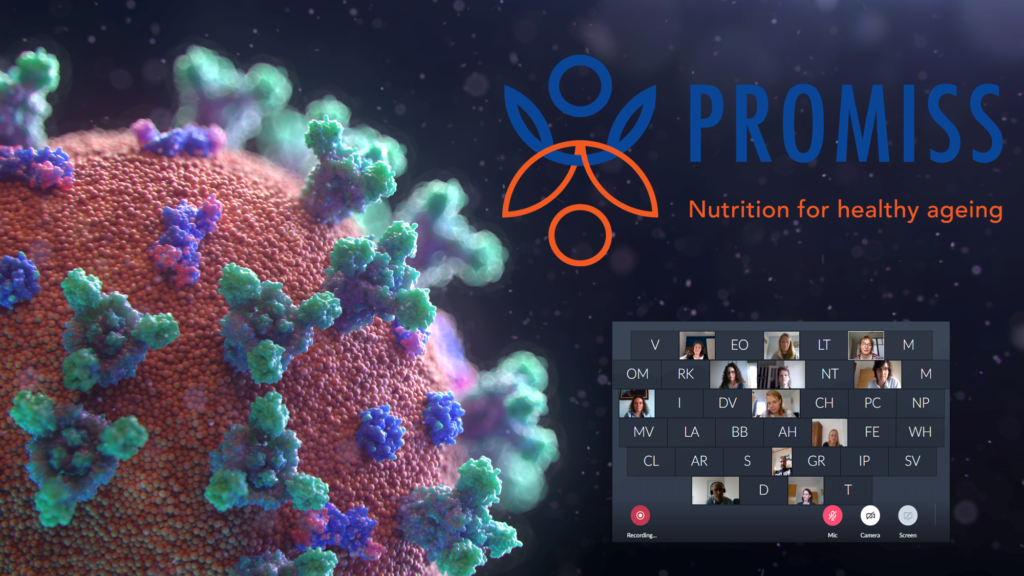
The outbreak of COVID-19, a new form of coronavirus, and its rapid spread around the world has required the PROMISS project partners to adapt to keep everyone safe and healthy.
- Our annual PROMISS consortium meeting was held virtually and although we couldn’t meet up face-to-face, we were able to have virtual in-depth discussions and decide effectively on the project’s next steps.
- Our PROMISS long-term (cost)effectiveness study also had to adapt its final tests to ensure participants’ health and safety. Starting from March 16 2020, the final follow-up measurement was postponed until further notice. Final measurements were resumed in April (through interview by phone) except for the physical measurements. Starting from the beginning of June, the physical measurements at the clinic site were also resumed in both Finland and the Netherlands. Those with no health complaints potentially caused by the coronavirus were allowed to visit the clinic site.
- The way PROMISS results are disseminated is impacted too. Our partners’ conferences European Geriatric Medicine Society – EuGMS and European Society for Clinical Nutrition & Metabolism – ESPEN are going virtual and the International Congress of Dietetics has been postponed to 2021. Nevertheless, we will make sure that the strategies developed based on our PROMISS research findings will be shared with the relevant target audiences.
The PROMISS consortium encourages everyone to follow the guidance of the World Health Organisation and government measures taken in our respective countries. For reliable information about the pandemic, please visit only trusted sources among which:
- European Commission (available in all EU languages) and European Centre for Disease Control
- World Health Organisation(available in different languages), including: WHO recommendation how to maintain good mental health during COVID-19
- COVID-19 and older people in Europe (from our partner AGE Platform Europe)
- Covid-19 and nutrition page from the American Society for Nutrition
Teuni H Rooijackers, Marga C Ocké, Linda M Hengeveld , Marjolein Visser, Jolanda MA Boer
Public Health Nutrition 2020, 1-13. doi:10.1017/S1368980020000026
Adequate protein intake is important for the health and physical functioning of older adults. There are indications that the timing of protein intake may influence total protein intake, but evidence is limited so far. Therefore we studied the association between timing of protein intake and the total amount of protein ingested in 739 community-dwelling Dutch older adults (70+), who participated in the Dutch National Food consumption Survey 2010-2012. Participants were interviewed at home by trained dieticians twice, with a mean interval of four weeks about all food and drinks they had eaten the day before. For all foods and drinks consumed, the amount and time of consumption was recorded. For each day we calculated how much protein the participant ingested. If the participant ingested less than 0.8 g protein per kilogram of body weight, protein intake was considered to be low that day.
The results showed that protein intake differed across hours of the day with peaks between 08:30-09:29h (mostly breakfast), 12:30-13:29h (mostly lunch), and 17:30-18:29h (mostly dinner). On the 290 days that protein intake was low, for each hour of the day the average amount of protein ingested was lower compared to the 1188 days with a higher protein intake. This lower intake at either time of day may, however, just reflect a lower food consumption and does not necessarily provide information on the distribution of protein intake over the day. Therefore, we also investigated how much of the total protein was ingested in the morning, midday or in the evening. On days with a low protein intake, a larger part of the total protein intake was ingested in the morning (22%), compared to days with a higher protein intake (17%). If a larger part of total protein was consumed in the morning, there was a higher change that the total protein intake of that day was low. Weaker associations were observed for the part of protein that was ingested midday or in the evening. These results confirm results of other studies on this topic and suggest that timing of protein intake may influence total protein intake. Drawing final conclusions on the effect of timing of protein on total protein intake from our study is difficult. It is important to look in more depth into the timing of protein intake in experimental studies actively manipulating protein intake at different hours of the day, to see if timing of protein intake can be used to increase the likelihood of an adequate protein intake among older adults.
You can access the full scientific article here
Our PROMISS partners VIVES and HAS – Universities of Applied Sciences in Belgium and the Netherlands – have been busy the last few weeks recording the first Masterclass videos targeting food industry.
These Masterclass videos in the form of webinars are embedding PROMISS scientific findings into the broader research context on protein malnutrition and translate them into more practical guidelines for food industry.
So far three videos have been recorded and are being edited right now.
Stay tuned for their release later this year!
“Behind the scenes” pictures


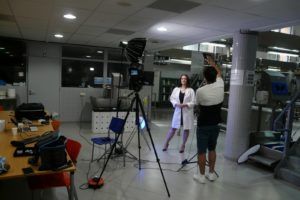
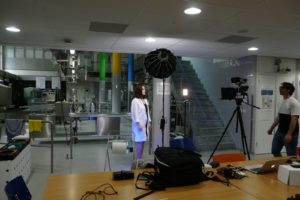
Ilse Reinders, Hanneke Wijnhoven, Marjolein Visser
Clin Nutr ESPEN. 2020 Jun;37:157-167. doi: 10.1016/j.clnesp.2020.02.020
As many older adults do not meet the (current and higher) recommendations, we examined the feasibility (effectiveness and appreciation) of two dietary advice strategies to increase protein intake following either an even distribution of protein consumption over the day (‘even’ strategy) or a peak in protein consumption during one meal moment (‘peak’ strategy).
Older adults aged ≥ 65 years (n=60) who live at home were randomised into one of three groups; two intervention groups (‘even’ or ‘peak’ strategy) and one control group. Over the course of four weeks, participants of both intervention groups received personalised dietary advice and protein enriched food products (such as puddings, rice pudding, coconut water and whey-protein powder) to increase their daily protein intake. The ‘even’ group was advised to consume a maximum of 20 g of protein during each meal or snack moment while the ‘peak’ group was advised to consume at least one daily meal with 35–45 g of protein.
Both intervention groups increased their protein intake after four weeks significantly compared to the control group and participants following the ‘peak’ strategy more often had at least one meal per day very high in protein (≥35 g). Both intervention groups considered the advice to increase protein as (very) clear, and most reported they would (partly) continue following the advice to increase protein intake.
The ‘even’ and ‘peak’ dietary advice strategies were effective in increasing protein intake in four weeks and both well appreciated by community-dwelling older adults.
You can access the scientific article here
Our PROMISS partner EuGMS (European Geriatric Medicine Society) organizes its 16th International Congress in Athens, Greece, 7-9 October 2020!
Abstract submission and call for Symposia are now open!
Conference Website: https://eugms.org/2020.html

Eva Kiesswetter, Bart JF Keijser, Dorothee Volkert, Marjolein Visser.
Eur J Clin Nutr. 2019 doi: 10.1038/s41430-019-0536-4.
As involuntary weight loss in older age is related to functional decline and to mortality, the knowledge about factors affecting body weight is of importance. One factor that may influence body weight in older people is the oral health status. Therefore, we aimed to investigate the longitudinal associations of different oral health characteristics with body weight in community-dwelling older adults.
We used data of 657 community-dwelling older adults aged 55-80 years from the Longitudinal Aging Study Amsterdam (LASA). The first assessment of oral health and body weight took place in 2005/07 and the second in 2015/16. To describe oral health status, aspects relating to teeth, dentures, and oral problems (e.g. bleeding gums) as well as the self-rated oral health were assessed.
The proportions of people being edentulous and wearing dentures increased during follow-up and the proportions of people suffering from oral health problems remained relatively stable over time. About two thirds of the participants rated their oral health status as healthy. In our analyses, only the self-rated oral health status was associated with body weight.
In community-dwelling older adults self-rated oral health may indicate changes in body weight in the long term. Therefore, this simple measure could serve to identify a risk for weight loss and to initiate oral interventions in clinical practice.
You can access the scientific article here

The Centre of expertise for Agrotechnology and Biotechnology at the VIVES University of Applied Sciences, Belgium, has gathered extensive expertise on malnutrition among older persons in the PROMISS project. Taking this expertise, VIVES developed specific training and education material for different actors within the practice-oriented research project “Seniorproof”.
For example, an “ambiance box“ was developed to inspire caregivers to decorate a meal attractively. In addition, a taste panel was set up that can help companies and industrial kitchens to develop new food products that are adapted to the preferences and needs of the older persons.
Learn more about VIVES’ work in the article 65+’ers en hun liefde voor de maaltijd (Dutch only)
Vanneste, E., Van den Broeck, L., Desplenter , A., & Schutyser, E. (2019). 65+’ers en hun liefde voor de maaltijd. Tijdschrift voor voeding en diëtetiek, 14-17
To make the PROMISS project even more accessible, the project partners have been working on visualizing key aspects of the project through videos. The first video (see below) gives an overview of the PROMISS project. Future videos will focus on first findings and provide insights into different partners’ roles and contributions to the project. Follow us on twitter @PROMISS_VU to not miss any new video releases on our PROMISS Project Youtube Channel
Nuno Mendonça, Andrew Kingston, Antoneta Granic, Carol Jagger.
Age and Ageing, afz142, https://doi.org/10.1093/ageing/afz142
Frailty is a clinical syndrome defined as an increased vulnerability to recover after a health shock. Pre-frailty and frailty are estimated to be present in 42% and 11% of community‐dwelling older adults respectively, and both increase with age. Frail older adults are at increased risk of disability, hospitalisation, care home admission and death. In this study we have used five criteria: muscle weakness, slow walking speed, low physical activity, exhaustion, and unintentional weight loss to define frailty. Malnutrition is central to all these criteria and it might be that a good intake of dietary protein is a viable strategy to change the progression of frailty in older adults by slowing down the progressive loss of muscle mass and physical function. We used data from a study on 700 very old adults that turned 85 years old in 2006/2007 living in North East England and we followed them until they were 90. Protein intake was estimated with a 24-hour multiple pass recall (people were asked what foods and drinks were consumed in the past 24 hours) on two different occasions in 2006/2007. We found that participants with higher protein intake were less likely to become frail if they were pre-frail to begin with. This was also true for those who had protein intake higher than 0.8 or 1.0 grams per kilogram of adjusted bodyweight. Energy intake seems to play an important role in this relationship between protein and frailty.
Eva Kiesswetter, Linda M. Hengeveld, Bart JF Keijser, Dorothee Volkert, Marjolein Visser.
Journal of Dentistry, Volume 85, June 2019, Pages 73-80 doi.org/10.1016/j.jdent.2019.05.017
Malnutrition is a state of energy or protein deficiency, which causes measurable changes in body functions. Among older people malnutrition is widespread and is associated with frailty, functional decline and poor quality of life. Malnutrition can be caused by multiple different factors such as disease-related, functional, psychological, and socio-economic aspects. Moreover, it is assumed that the oral health status plays a role in the development of malnutrition, as mastication and insalivation are important steps in eating and digesting. Therefore, the aim of our study was to investigate the association of different oral health characteristics and the development of malnutrition during 9-years in community-dwelling older adults.
The data used were from the Longitudinal Aging Study Amsterdam (LASA). We included participants aged 55-80 years without malnutrition at the beginning of the investigation. To describe oral health status, aspects relating to teeth, dentures, oral hygiene and oral problems (e.g. bleeding gums) as well as the self-rated oral health were assessed.
Of the 19 investigated oral health characteristics, toothache while chewing was identified to increase the risk of devolving malnutrition. In addition, for a poor self-rated oral health and the feeling of a dry mouth in combination with having no teeth we found indications that they might play a role in the long-term development of malnutrition. Regarding strategies to prevent malnutrition in older people these three aspects are of specific interest as they are modifiable and can be easily assessed by self-reports.
You can access the scientific article here
K.S. Fluitman, H.J. Nadar, D.S. Roos, H.W. Berendse, B.J.F. Keijser, M. Nieuwdorp, R.G.Ijzerman, M. Visser
J Nutr Health Aging (2019). https://doi.org/10.1007/s12603-019-1241-7
A common phenomenon amongst older adults is a decline in appetite, which is thought to contribute to the occurrence of undernutrition. This decline in appetite is called: “Anorexia of Aging”. Many factors are thought to contribute to anorexia of aging, including a decrease in smell function as we become older. A deteriorating sense of smell is believed to diminish eating pleasure and change people’s food-related choices. This would then lead to lower food intake and ultimately undernutrition.
In this study, we evaluated whether sense of smell was associated with appetite, weight change and BMI. In other words: do people with poorer sense of smell also report poorer appetite, suffer more weight loss and have a lower BMI? In 2012-2013, we used a commercially available smell test (the 40-item UPSIT test) to assess sense of smell in 824 Dutch older adults, aged 55-65 years old. All these older adults were also enrolled in the larger LASA-study which studies the consequences of aging in the Netherlands. In addition to the results of the smell test, we made use of the self-reported appetite, weight, and BMI, as well as many other variables measured by LASA.
Ultimately, 673 participant had correctly filled out the UPSIT-test and were included in this study. No association between sense of smell and appetite or weight change could be found. However, there was an association between poorer sense of smell and lower BMI in older adults who smoke, but not in older adults who do not smoke.
This means that poor sense of smell in older adults who also smoke might be a vulnerable group when it comes to undernutrition.
You can also read the scientific article here.
Alessandra C. Grasso, Yung Hung, Margreet R. Olthof, Wim Verbeke and Ingeborg A. Brouwer
Nutrients 2019, 11, 1904; doi:10.3390/nu11081904doi.org/10.1111/jgs.16011
Considering today’s environmental challenges such as climate change and biodiversity loss, sustainable dietary strategies are needed to meet the high protein requirement of a growing aging population. This study investigated the readiness of older adults to accept the consumption of the following alternative, more sustainable protein sources: plant-based protein, insects, single-cell protein, and in vitro meat. We used data from a survey that was conducted among 1825 older adults aged 65 years or above living in the United Kingdom, the Netherlands, Poland, Spain, and Finland.
Dairy-based protein was the most accepted protein source among older adults, with 75% of the respondents reporting dairy to be acceptable or very acceptable. When it came to alternative, more sustainable protein sources, 58% of the respondents reported to accept plant-based protein, 20% reported to accept single-cell protein, 9% reported to accept insect-based protein, and 6% reported to accept in vitro meat-based protein. We found that fussy eaters were less likely to accept eating alternative, more sustainable protein sources. Older adults who were more active in sustainable food consumption (e.g. purchases organic food) and who were highly educated were more likely to accept eating alternative, more sustainable sources. Valuing health, sensory appeal, and price when making food choices, as well as gender and country of residence were found to influence acceptance, although not consistently across all the protein sources.
This paper concludes that a relatively high acceptance of plant-based protein sources provides an opportunity to increase protein intake in an environmentally sustainable way in EU older adults. More research is needed to determine ways to increase acceptance of more innovative, technology-driven protein sources such as single-cell protein and in vitro meat among older adults.
You can also read the scientific article here.
Linda M. Hengeveld, Hanneke A.H. Wijnhoven, Margreet R. Olthof, Ingeborg A. Brouwer, Eleanor M. Simonsick, Stephan B. Kritchevsky, Denise K. Houston, Anne B. Newman, Marjolein Visser.
Journal of the American Geriatrics Society. (2019) 00:1-8 doi.org/10.1111/jgs.16011
Frailty can be described as a fragile health state that makes a person very vulnerable for health problems. Frail older persons are at higher risk for developing mobility problems, becoming institutionalized and losing independence. For older adults and their families, the possibility to postpone or prevent the development of frailty is likely highly desirable.
Diet is one of the modifiable factors that are supposed to contribute to the prevention of frailty in older adults. Moreover, previous studies have shown that many older adults consume a diet that is of insufficient quality (i.e., their diet does not fully conform to national dietary guidelines) or that is low in protein. We investigated whether poor diet quality and low protein intake would increase the risk of developing frailty in the future.
The data are from the Health, Aging, and Body Composition (Health ABC) Study, which consists of community-dwelling older adults aged 70 years and over, who live in the areas of Memphis, TN, and Pittsburgh, PA (USA).
We found that older adults with a poor-quality diet had a higher risk of developing frailty compared to older adults with a good-quality diet. We found no relationship between protein intake and risk of frailty. In conclusion, our study suggests that it is important to adhere as much as possible to the national dietary guidelines for older adults to postpone or prevent the development of frailty.
You can also read the scientific article here
Nuno Mendonça, Andrew Kingston, Antoneta Granic, Tom R. Hill, John C. Mathers, Carol Jagger
European Journal of Nutrition 2019 Jan 10. doi.org/10.1007/s00394-019-02041-1
We aimed to determine the contribution of protein intake, and the interaction between protein intake and physical activity, to the transition between disability free and disability using the Newcastle 85+ Study. We included more than 700 older adults living in the community and turning 85 in 2006/2007 and we followed them until 90 years of age. Protein intake was estimated with a 24-hour multiple pass recall (people were asked what foods and drinks were consumed in the past 24 hours) on two different occasions in 2006/2007. Study participants were also asked about their ability to perform 17 activities of daily living (ADL) (able to get in and out of a chair, cut own toenails, manage own medications, etc.) in 2006/2007, and after 18, 36 and 60 months. A simple score was derived by summing the number of ADLs that the participant had difficulty with and a score >1 was considered as disability. We found that an increase in protein intake, especially ≥0.8 or 1g of protein per kg of adjusted body weight per day (g/kg aBW/d) decreased the likelihood of developing disability. An average 85-year-old with protein intake <1g/kg aBW/d was expected to spend 0.86 years disability free and 3.63 years disabled over 5 years while another participant with ≥1.0 g/kg aBW/d was expected to spend 1.58 years disability free and 3.01 years disabled. We also found that those physically active and with a good protein intake were less likely to transition from disability-free to disability than those within the same physical activity level but with worse protein intake. This means that higher protein intake, especially in combination with higher physical activity may delay the incidence of disability in very old adults.
L. M. van der Lubbe, M. C.A. Klein
Proceedings of the 13th EAI International Conference on Pervasive Computing Technologies for Healthcare, PervasiveHealth 2019
In this paper we introduce a system that uses persuasive communication to stimulate the participants of the PROMISS project to be adherent to their diet advice. We have done literature research towards the different personalization strategies that can be used for persuasive communication. In order to personalize the messages that are send by the system, user characteristics such as gender and personality traits can be used. Furthermore, the design of the system is tailored to the elderly target group. Existing literature towards design principles for elderly is consulted during the design process.
We have first created a prototype of the system and we evaluated this prototype during a pilot study with seven participants. From this pilot we learned more about how the users perceive the system, which gave us insights that are used to improve the system. One important remark made by the participants was about the limited added value of the system in their diet. Such remarks are taken into account for the next version of the application. Furthermore, we extended the requirements of the system with input from the dietitians from PROMISS, to take into account how the diets will be designed in the next trial of the PROMISS project. We have briefly evaluated the new design with participants of the pilot, who were very enthusiastic about the changes made. The system described in this paper will be used in the next trial of the PROMISS project.

Prof. Marian de van der Schueren, our PROMISS member from ESPEN (European Society for Clinical Nutrition and Metabolism), is spreading the word in the Netherlands on the importance of increasing protein intake for older adults.
“Stay fit: eat more protein!” published in a magazine for older people (KBO-PCOB Magazine) includes 7 robust tips from our PROMISS partner on how to ensure you’re getting enough protein and also lists 25 foods rich in protein such as tenderloin, salmon, milk, eggs or walnuts.
Addressing an even wider audience in the NRC (Dutch national newspaper), “Ageing healthy with proteins” also focuses on why protein is important for older people: “Proteins are essential for preserving muscle mass, resilience and your mental state”, explains Prof. de van der Schueren.
Read the full articles in Dutch here:
PROMISS will be showcased with a scientific symposium under the Theme “Determinants and drivers across the lifcycle” at FENS 2019, taking place on 15-18 October 2019 in Dublin.
Download the Preliminary Programme.
Register before the 8th of May to get the super early bird fee!
Yung Hung, Hanneke A. H. Wijnhoven, Marjolein Visser and Wim Verbeke
Nutrients 2019, 11(4), 777; https://doi.org/10.3390/nu11040777
European older adults have been studied according to their appetite and protein intake profiles, and the relevant dietary and physical activity behavioural determinants were identified. A survey with 1,825 older adults aged 65 years or above in five European countries (Netherlands, United Kingdom, Finland, Spain and Poland) was conducted in June 2017.
Older adults with a poor appetite and lower level of protein intake is characterized by a larger share of people aged 70 years or above, living in the UK or Finland, having an education below tertiary level, who reported some or severe financial difficulties, having less knowledge about dietary protein and being fussier about food. This group also tends to have a higher risk of malnutrition in general, oral-health related problems, experience more difficulties in mobility and meal preparation, lower confidence in their ability to engage in physical activities in difficult situations, and a lower readiness to follow dietary advice. Therefore, effective dietary strategies to increase protein intake should take into account sensory properties, familiarity, affordability, accessibility and convenience.
Consumption of certain foods at a certain moment of the day and physical activity level or pattern were associated with a lower risk of having lower protein intake. Low level of physical activity emerged as a risk factor for having a lower protein intake in older adults with poor appetite, and vigorous physical activities between lunch and dinner were associated with a lower risk in older adults with good appetite.
This study provides an overview and highlights the similarities and differences in older adults’ profiles, as well as the challenges in promoting healthy ageing regarding protein intake. Recommendations for optimal dietary and physical activity strategies to prevent protein malnutrition were derived, discussed and tailored according to older adults’ profiles.
Antoneta Granic, Nuno Mendonça, Avan A. Sayer, Tom R. Hill, Karen Davies, Mario Siervo, John C. Mathers, Carol Jagger
Clinical Nutrition 2019 Jan 10. doi.org/10.1016/j.clnu.2019.01.009 [Epub ahead of print].
Sarcopenia is a progressive loss of muscle mass and muscle strength that may lead to disability, falls, and hospitalisation. The very old, those aged 85 years and older, are the fastest growing age group in most western societies and are at especially high risk of sarcopenia. Onset of sarcopenia may be partly explained by diet. Therefore, we aimed to explore the role of dietary patterns and protein intake in the risk of sarcopenia over 3 years. Our study, the Newcastle 85+, was based in North East England, and involved more than 750 people aged 85 years old. These participants had their diet estimated by a 24 hour multiple pass recall (people are asked what foods and drinks they consumed in the past 24 hours) on two different days of the week and from this, dietary patterns were derived. Sarcopenia was measured over 3 years according to a muscle mass index, gait speed and grip strength. We identified three dietary patterns: ‘Low Red Meat’, ‘Traditional British’ and ‘Low Butter’ that varied by unsaturated fat spreads/oils, butter, red meat, gravy and potato consumption. We found that very old adults who had a dietary pattern high in foods characteristic of a traditional British diet (high butter, red meat, gravy and potato consumption, and high fat and energy intake), especially compared to a low butter dietary pattern (high in unsaturated fat spreads/oils, fibre, percentage of energy from protein and starch) had an increased risk of sarcopenia even when overall protein intake was good. These results add to the limited literature on the role of the whole diet in sarcopenia in very old adults.
Over 20 million older citizens are at risk of protein malnutrition in Europe, whose consequences on health are serious and often irreversible.
Based on the outcomes of our research, PROMISS will develop optimised, sustainable and evidence-based dietary and physical activity strategies, which are currently tested in the Netherlands and Finland for effectiveness and cost-effectiveness in a long-term intervention study.
The project will show whether these strategies together with new food concepts and products will prevent malnutrition and support active and healthy ageing.
- A sneak peek of PROMISS research (p. 2-5)
- Consumers’ habits and their consequences
- Enriched bread with raisins and apple pie
- Protein rich soups
- Towards tailored dietary strategies
- Daily sedentary time and physical activity among Dutch older adults
- Nutrition and appetite under the magnifying glass (p. 6-7)
- The Protein Screener 55+: interview with Dr. Hanneke Wijnhoven
- What comes next? (p. 7-8)
- Read about what keeps our team busy in the coming months
Enjoy reading the third PROMISS newsletter here.
Avec le vieillissement de la population européenne, le défi consiste à maintenir un nombre croissant de personnes âgées dans tous les pays européens en bonne santé et actifs. En Europe, entre un cinquième et la moitié des adultes plus âgés vivant à la maison souffrent de malnutrition ou risquent de souffrir de malnutrition protéino-énergétique. PROMISS a pour objectif de mieux comprendre et finalement prévenir la malnutrition protéino-énergétique chez les personnes âgées. PROMISS contribuera ainsi à améliorer le vieillissement actif et en bonne santé.
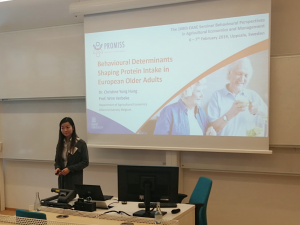
Our PROMISS partner, Christine Yung Hung from the University of Ghent, Belgium, presented PROMISS project results at the 168th EAAE Seminar on 7 February in Uppsala, Sweden.
The seminar addressed the questions of behavioural perspectives in agricultural economics and management by an exchange of current ideas and knowledge related to the effect of human personal characteristics, values, rationality, attitudes, emotions, goals, cognition etc. on production and consumption decisions.
Christine Yung Hung’s presentation contributed to the theme by presenting some of PROMISS’ WP4 results under the heading “Behavioural Determinants Shaping Protein Intake in European Older Adults”. PROMISS’ WP4 aims to quantify specific attitudes and preferences of older adults, as food consumers, with regard to dietary and physical activity characteristics and daily patterns according to appetite and malnutrition strata, and was therefore an excellent fit for the seminar’s overall theme.
Sharing insights these insights will help the advancement of the academic field but may also contribute to the formulation of efficient and effective public and private policy schemes, advisory support, and measures to affect production and consumption choices.
| Visit the official EuGMS Congress webite to discover more! Download now the Preliminary Programme. See the 80+ Early Confirmed Speakers. Find out how you can sponsor or exhibit. Register now to get the early bird fee. Register now! |
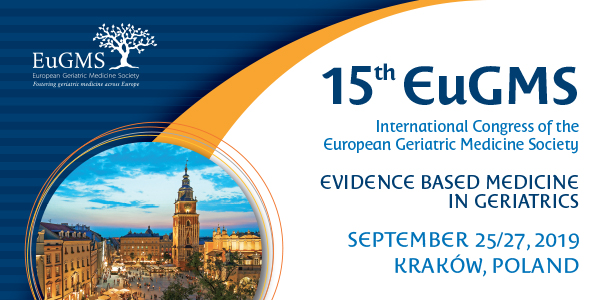
Daily sedentary time and physical activity among Dutch older adults
Higher physical activity is associated with lower chronic disease risk among older adults. However, less is known about the optimal balance between daily physical activity and sedentary time and their correlates among older adults. In this study van Ballegooijen et al from the VU University in Amsterdam objectively measured physical activity patterns and assessed its correlates in a large sample of older Dutch adults. In addition, they examined different combined profiles of sedentary time and physical activity across strata of sex, age, education and BMI groups.
They made use of cross-sectional data from 1,201 participants of the 2015-2016 examination of the Longitudinal Aging Study Amsterdam, a population-based cohort of older Dutch adults. The mean age was 71 year and 51% were women Participants were instructed to wear an Actigraph accelerometer for 7 consecutive days at the right hip. Time spent in sedentary (<100 counts per minute [cpm]), light (100-2020 cpm), and moderate and vigorous activity (MVPA) ≥2020 cpm) were calculated and compared across age, sex, education and BMI groups.
The authors conclude that the majority of wake time was spent sedentary 65% followed by light (33%), and moderate to vigorous physical activity (2%). Higher age and higher BMI were related to more time spent sedentary, while female sex and lower education were related to less time spent sedentary. The combination of high sedentary time and low physical activity was significantly associated with higher age, higher BMI, and slower walking speed compared to the combination of low sedentary time and high physical activity. This suggests that increasing light activity might be an effective and feasible strategy in older persons to reduce sedentary time.
In a nutshell, these are the key findings of the study:
- Dutch older adults spend on average 65% of their waking time sedentary.
- Older adults’ sedentary time differs by age, sex, education and BMI groups.
- The combination of high sedentary time and low physical was associated with higher age, higher BMI, and slower walking speed compared to the combination of low sedentary time and high moderate to physical activity.
Ben je een onderzoeksassistent met affiniteit voor de wetenschap die maatschappelijke impact wil hebben? Solliciteer dan bij de Vrije Universiteit Amsterdam (VU).
Locatie: AMSTERDAM
Functieomschrijving
De onderzoeksassistent voert praktisch werk uit voor een interventiestudie naar het effect van voeding op gezond ouder worden. Hij/zij richt zich voornamelijk op het werven van studiedeelnemers, het screenen van mogelijk deelnemers, het invullen van studiegegevens, en overige administratieve taken ten behoeve van de studie.
Jouw taken
- werven van studie deelnemers
- screenen van mogelijke deelnemers
- invoer van studiegegevens in database
- diverse administratieve taken
Functie-eisen
- afgeronde HBO opleiding (richting van voeding en diëtetiek is een pré)
- werkervaring in onderzoeksetting is een pré
- goed inlevingsvermogen en affiniteit met ouderen
- zelfstandig en flexibel ten aanzien van werkinhoud en werkdagen
- goede mondelinge en schriftelijke communicatie vaardigheden
Wat bieden wij?
Een uitdagende functie bij een maatschappelijk betrokken organisatie. Het salaris bedraagt afhankelijk van opleiding en ervaring op voltijdse basis minimaal € 2.579,- en maximaal € 2.972,- bruto per maand, conform salarisschaal 8.0- 8.3. De functie is ingedeeld volgens UFO-profiel (Onderwijs-/Onderzoeksmedewerker 3) en staat open voor 0.6 fte.
De arbeidsovereenkomst wordt aangegaan voor een periode van 9 maanden.
Daarnaast beschikt de VU over aantrekkelijke secundaire arbeidsvoorwaarden en regelingen die een goede combinatie van werk en privé mogelijk maken, zoals:
- maximaal 41 vakantiedagen bij een voltijds dienstverband
- 8% vakantietoeslag en 8,3% eindejaarsuitkering
- ruime bijdrage aan ABP-pensioenregeling
- bijdrage aan reiskosten voor woon-werkverkeer
- keuzemodel voor fiscale uitruil van bepaalde arbeidsvoorwaarden
Over de VU
Bijdragen aan een betere wereld door onderscheidend onderwijs en grensverleggend onderzoek, dat is de ambitie van de VU. Een universiteit waar persoonlijke vorming én maatschappelijke betrokkenheid centraal staan. Waar we vanuit verschillende disciplines en achtergronden samenwerken aan innovaties en nieuwe inzichten. Ons onderzoek beslaat het hele spectrum: van alfa, gamma en bèta tot leven en medische wetenschappen.
Aan de VU studeren ruim 23.000 studenten en werken ruim 4.500 medewerkers. De uitstekend bereikbare VU-campus is gevestigd in het hart van de Amsterdamse Zuidas, een inspirerende omgeving voor onderwijs en onderzoek.
Faculteit der Bètawetenschappen
De Faculteit der Bètawetenschappen inspireert wetenschappers en studenten om duurzame oplossingen te vinden voor complexe maatschappelijke vraagstukken. Van bosbranden tot big data, van obesitas tot geneesmiddelen en van molecuul tot de maan: ons onderwijs en onderzoek beslaan de volle breedte van de bètawetenschappen. Nationaal en internationaal delen wij kennis en ervaring met vooraanstaande wetenschappelijke instituten en het bedrijfsleven.
Werken bij Bètawetenschappen is samenwerken met studenten, promovendi en wetenschappers met focus op hun vak én een brede blik op de wereld. De faculteit telt ongeveer 5.750 studenten en er werken ruim 1.250 medewerkers.
Afdeling Gezondheidswetenschappen
De sectie Voeding en Gezondheid van de afdeling Gezondheidswetenschappen, Faculteit der Aard- en Levenswetenschappen leidt onder meer het Europese project PRevention Of Malnutrition In Senior Subjects in the EU (PROMISS) (https://www.promiss-vu.eu/). PROMISS heeft als doel om ondervoeding bij ouderen te begrijpen en uiteindelijk te voorkomen en gezond ouder worden te bevorderen. In oktober 2018 is er een langlopende interventiestudie gestart waarbij het effect van een voeding op gezond ouder worden onderzocht wordt.
Diversiteit
Diversiteit is een kernwaarde van de VU. Wij staan voor een inclusieve gemeenschap en geloven dat diversiteit en internationalisering bijdragen aan de kwaliteit van onderwijs en onderzoek. We zijn dan ook voortdurend op zoek naar mensen die door hun achtergrond en ervaring bijdragen aan de diversiteit van onze campus.
Solliciteren
Ben jij geïnteresseerd in deze functie? Stuur dan een e-mail met jouw curriculum vitae en motivatiebrief vóór 7 februari 2019 onder vermelding van vacature ONDERZOEKSMEDEWERKER t.a.v.
Naam: Ilse Reinders
Functie: Postdoc onderzoeker
E-mail: sollicitaties.agw.falw@vu.nl
Vragen
Voor vragen over de vacature kun je contact opnemen met:
Naam: Ilse Reinders
Functie: Postdoc onderzoeker
E-mail: promiss-onderzoek@vu.nl of ilse.reinders@vu.nl
Telefoon: 020-5986969
Acquisitie naar aanleiding van deze advertentie wordt niet op prijs gesteld.
Protein shakes don’t count: Why older adults should eat real food
NBC News publishes an article on protein mentioning the results of the study performed by PROMISS researcher Nuno Mendonca.
« Older adults need to eat more protein-rich foods when they’re trying to lose weight, dealing with a chronic or acute illness, or facing a hospitalization, according to a growing consensus among scientists. »
The article mentions the results of a study published in 2017 by PROMISS researcher Nuno Mendonca and followed nearly 2,000 older adults over six years: « People who consumed the least amount of protein were almost twice as likely to have difficulty walking or climbing steps as those who ate the most, after adjusting for health behaviors, chronic conditions and other factors. »
The article can be found here: https://www.nbcnews.com/health/aging/protein-shakes-don-t-count-why-older-adults-should-eat-n959926
The whole PROMISS scientific article can be found here: https://promiss-vu.eu/wp-content/uploads/Mendon-a_et_al-2019-Journal_of_the_American_Geriatrics_Society.pdf
Save the date for the #EFADConference organised by the PROMISS_VU project partner EFAD. The conference is taking place in #Berlin on 1 & 2 November 2019. The theme this year is ‘Breaking Professional Boundaries’. Preliminary programmes for this event will be available 1 March. Details at: https://efadconference.com/
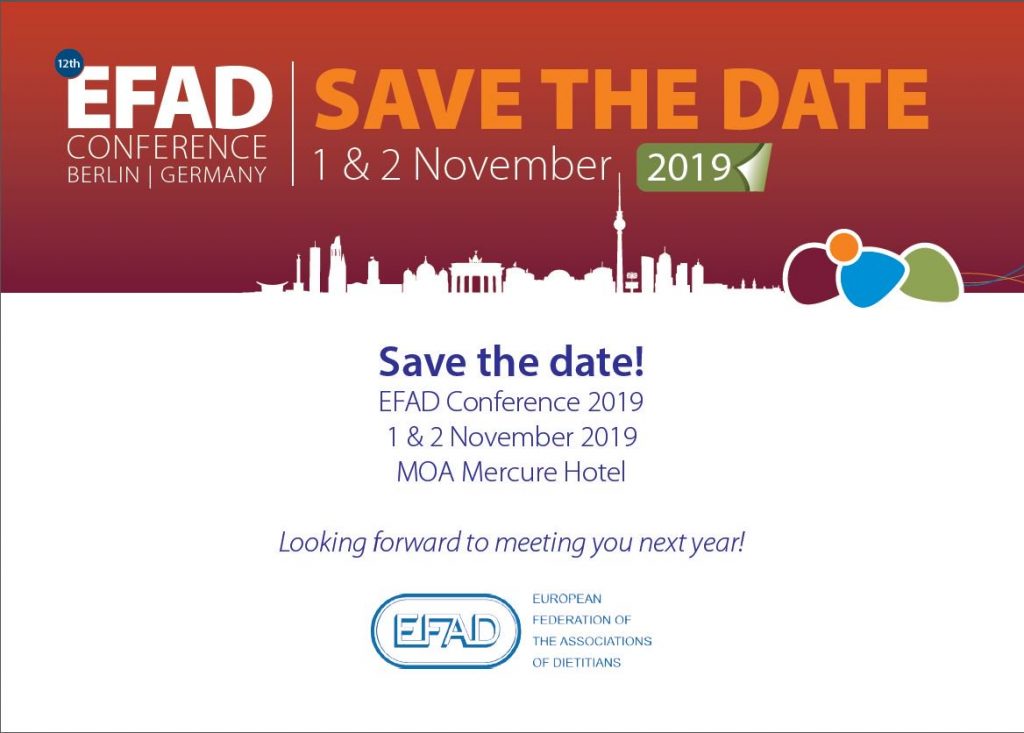

You can now contribute to ESPEN 2019 by submitting your research in the field of clinical nutrition and metabolism.
Be sure to read the submission guidelines carefully to ensure that your abstract complies with the guidelines set out by the Abstract Grading Committee.
Take a look the abstract topics available.

We are delighted to inform that the PROMISS project has been included as good practice to the « Optimal Nutritional Care for All » (ONCA) website. This confirms that our project is a pioneering innovative to improve nutritional care and screening across Europe.
A comprehensive study on the long-term (cost)effectiveness of solutions for tackling malnutrition in older age has started.
Under the aegis of WP8 leaders, participants are currently recruited in the Netherlands and in Finland.
If you wish to join in and contribute to the study, click on the respective following links to find additional information regarding Dutch and Finnish respectively:
[DUTCH] Wilt u meer informatie over het PROMISS onderzoek, klik hier.
[FINNISH] Lisätietoja PROMISS-tutkimuksesta saat napsauttamalla tätä.
We hope to have you on board and do not hesitate to spread the word !
Thank you very much in advance !
Comparison of protein intake per eating occasion, food sources of protein and general characteristics between community-dwelling older adults with a low and high protein intake
Linda M. Hengeveld, Anouk D.A. Pelgröm, Marjolein Visser, Jolanda M.A. Boer, Annemien Haveman-Nies, Hanneke A.H. Wijnhoven
Clinical Nutrition ESPEN, https://doi.org/10.1016/j.clnesp.2018.10.013
Adequate protein intake is required to maintain muscle health, which is of great importance for prevention or delay of disability and mortality. However, a substantial part of older adults has a protein intake below the recommended 0.8 gram per kg body weight per day. In this study we explored the timing of the day, the origin (animal or vegetable) and food sources of protein intake of older adults (70 years and older) from The Netherlands. We also examined if we could characterize older adults with a low protein intake. For example, are they lower educated, do they have difficulties with walking or are they living alone? This knowledge will help us to develop strategies to improve the diet of older adults with a low protein intake.
We found that 15% of these older adults had a protein intake below the recommended 0.8 gram per kg body weight per day. Compared to older adults with a high protein intake, older adults with a low protein intake consequently ate less protein at all meal moments (breakfast, lunch, dinner, snack moments) Furthermore, older adults with a low protein intake ate less protein from animal origin than older adults with a high protein intake. The biggest food sources of protein were similar among those with a low and a high protein intake: dairy, meat and cereals. Out of a long list of characteristics, we only found that older adults who follow a diet, who are obese an who don’t drink alcohol are more likely to have a low protein intake. However, in general we did not find that there is a specific group of characteristics that defines older adults with a low protein intake, which means that this can occur in every older person.
This study shows that the timing and animal versus vegetable origin of protein intake differs between older adults with a low and with a high protein intake. Because food sources and characteristics appear largely similar between those with a high and low protein intake, strategies to improve the diet of older adults with a low protein intake should target a broad population and multiple food sources.
The whole scientific paper can be found here:
https://clinicalnutritionespen.com/article/S2405-4577(18)30552-7/fulltext
The Department of Agricultural Economics of the Faculty of Bioscience Engineering of the Ghent University is looking for a highly motivated full‐time PhD student to work on the topic “Food and Physical Activity Preferences of Older Adults with Low Protein Intake” in a two-year appointment, which may be renewed, depending on future research grants.
The PhD research will be related to consumer behaviour and supervised by Prof. Wim Verbeke and Dr. Christine Yung Hung.
The research work is part of the project – PROMISS – Prevention of malnutrition in senior subjects in the EU, funded by the European Commission under the Horizon 2020 Research and Innovation programme. The aim of this project is to contribute and improve active and healthy ageing. The collaboration with an international team within and beyond the project consortium will expand the professional network of the appointed PhD, who will also receive the opportunity to present its work at (inter)national congresses and meetings and publish its results in peer-reviewed scientific journals.
Please find more information in https://www.ugent.be/en/work/vacancies/scientific/phd-student-yimgo.
PROMISS is participating in the 14th International Congress of the EuGMS, to be held from the 10th to the 12th of October 2018 in Berlin, Germany.
The congress theme is “Advancing Geriatric Medicine in a Modern World”.
Partners of the PROMISS project will receive you at at booth #06 and are also presenting two posters P434 and P435 result of research by Linda Hengeveld.
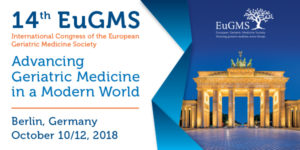
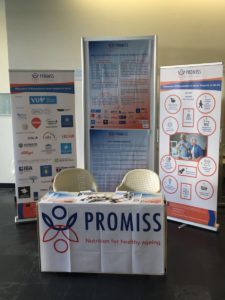
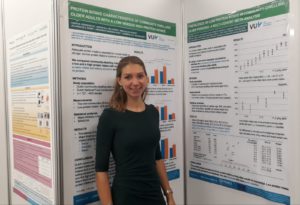
Nutritioninsight spoke with Dr. Christine Yung Hung of the Department of Agricultural Economics at Ghent University about protein intake preferences among elderly adults.
She presented on her research on agro-food marketing and consumer behaviour at the 40th European Society for Clinical Nutrition and Metabolism (ESPEN) Congress, held in Madrid.
Have a look at the interview in this video.
With the theme “Nutrition without borders” the ESPEN Congress 2018 (1-4 September 2018, Madrid, Spain) intends to explore new topics in clinical nutrition, in different clinical settings, besides the multidisciplinary and worldwide environment of the Congress.
Working in close collaboration with the ESPEN Committee Members, an attractive program represents an opportunity for physicians, dietitians, pharmacists, nutritionists, scientists and nurses involved in the field of nutrition and metabolism to meet and discuss cutting edge science in an informal atmosphere, strengthening old and sparkling new collaborations.
PROMISS will be displayed there, thanks to the direct participation of ESPEN as a partner, and VUA as coordinator.
Come and visit us on Booth no. 71 in the Exhibition Hall!
For more information, please contact ilenia.gheno@age-platform.eu
Hanneke A.H. Wijnhoven, Liset E.M. Elstgeest, Henrica C.W de Vet, Mary Nicolaou, Marieke B. Snijder, Marjolein Visser, May 2018
In order to preserve muscle mass and physical function, it is important to consume a sufficient amount of protein with food. However, research shows that around 50% of adults aged 65 years and older consume less than 1.0 gram/kg body weight of protein per day.
The practical question is how to calculate if you fall in this case?
PROMISS researchers set up a short food questionnaire, named the Protein Screener 55+ or Pro55+ to provide you with the probability for low protein intake in community-dwelling older people.
The Pro55+ finally consists of questions on weight and height, and the consumption (amount on average day or frequency in 4 weeks) of: slices of bread (number); glasses of milk (number); meat with warm meal (portion size); cheese (amount and frequency); dairy products (like yoghurt) (frequency); egg(s) (frequency); pasta/noodles (frequency); fish (frequency); and nuts/peanuts (frequency).
Validation tests proved that the Pro55+performs well in discrimination persons with a low and high protein intake.
Our conclusion is that the Pro55+ can be used to validly screen for protein intake below 1.0 gram/kg body weight of protein per day in community-dwelling older adults.
Available in English, its online version can be found at www.proteinscreener.nl.
PROMISS encourages such tool to be up-taken and used in other countries, and in other languages as well.
Publication in: PLOS ONE, May 23, 2018, https://doi.org/10.1371/journal.pone.0196406
The EFAD conference will be on stage on September 28th and 29th in Rotterdam, the Netherlands.
The meeting place with dietitians from all over Europe is the World Trade Centre in Rotterdam.
Researchers are warmly encouraged to the inform and disseminate about their projects and results, by submitting abstract and present at the Conference.
Where are you on the 28th and 29th of September 2018? At the EFAD Conference in ! Now is your chance to meet dietitians from all over Europe!
The deadline for submitting abstracts of original research is 1 June 2018.
More information at the EFAD website.
Bedingt durch den demographischen Wandel in Europa mit einem steigenden Anteil der älteren Bevölkerung wird es immer wichtiger, dass ältere Menschen in ganz Europa gesund und aktiv bleiben.
In Europa sind zwischen einem Fünftel und der Hälfte der älteren Menschen, die zu Hause leben, unterernährt oder es besteht das Risiko einer Protein-Energie-Mangelernährung. PROMISS hat sich zum Ziel gesetzt, die Proteinmangelernährung bei Senioren untersuchen und ihr letztendlich vorzubeugen. Damit trägt PROMISS zur Verbesserung des aktiven und gesunden Alterns bei.
Healthcare and communications professionals will bring PROMISS-results to the older adults
The world is facing a situation without precedent: we will soon have more older people than children, and more people at very
old age than ever before. When looking at nutrition in old age, it strikes that more than 90 % of older people in Europe are living at home, and a very poor appetite is reported by 10–15 % of them, which, consequentially, causes malnutrition, and a ‘cascade’ of deteriorated body functions and illnesses; muscle loss, cognitive decline, weak immune systems and slowed wound healing.
The PROMISS project intends to tackle malnutrition, and Professor Marjolein Visser from Vrije Universiteit Amsterdam explains that, in order to design concrete and tailored solutions, optimal protein intake combined with physical activity at certain time points release extra positive effects on ageing. We should however not be left alone in improving our nutrition: the support by healthcare professionals is key.
Discover more in the extensive article, appeared in the BIOECONOMY INNOVATION – COMMBEBIZ MAGAZINE 2017-2018
Across Europe, one out of five older adults living at home is malnourished, or at risk of protein-energy malnutrition. Improving protein intake might prevent malnutrition.
Many older persons today do not meet the current Recommended Dietary Allowance (RDA) of protein intake, which may lead to mobility limitations, loss of muscle strength, and increases the risks of chronic protein-energy malnutrition. There is increasing evidence that adequate protein intake is crucial in old age, which makes recognition of low protein intake key, and interventions to prevent malnutrition essential.
These are the issues at the core of the PROMISS research, and you can read about this in our first press release.
PROMISS and the Health ABC Study
The Health, Aging and Body Composition (Health ABC) Study is one of the longitudinal studies contributing to work package 1 of PROMISS. The Health ABC cohort consists of 3,075 black and white US older adults aged 70 years and over, who were generally well-functioning at baseline. The main focus of the Health ABC study is to determine risk factors for functional decline and loss of independence in healthier older people.
Since the start of PROMISS in April 2016, several researchers have used the Health ABC data to investigate associations of dietary intake with appetite, malnutrition and mobility limitation in US older adults. In the first paper, entitled “Protein intake and mobility limitation in community-dwelling older adults: the Health ABC Study”, it was hypothesized that older adults with low protein intake would have a greater risk of developing mobility limitations than those with higher protein intake. The results confirmed the hypothesis: it was shown that older adults with a lower protein intake (<0.7 and 0.7-<1.0 kg/kg body weight/d) had a higher risk of developing mobility limitations in the following 6 years compared to older adults with the highest protein intake (≥1.0 g/kg body weight/d).
The second paper, entitled “Poor appetite and dietary intake in community-dwelling older adults”, focused on differences in food intake in community-dwelling older adults with different appetite levels. This study showed that 21.8% of the participants had a poor appetite. Those participants consumed less protein, dietary fiber, whole grains, fruits and vegetables, but consumed more dairy foods, fats, sweets and sodas compared to the participants with a very good appetite.
The association between diet quality and protein-energy malnutrition was investigated in the third paper, entitled “Prospective associations of poor diet quality with long-term incidence of protein-energy malnutrition in community-dwelling older adults: the Health, Aging and Body Composition Study.” This study showed that the majority of the participants consumed a diet of insufficient quality and that 40% of the participants had a protein intake below the recommended daily intake. Furthermore, in 4 years almost 25% of the participants developed protein-energy malnutrition. It was observed that a higher protein intake may reduce the risk of developing persistent protein-energy malnutrition.
Researchers of work package 1 of PROMISS are currently working on a two other studies by using data from the Health ABC Study. In the first one, those data will be used in a multi-cohort paper on determining the prevalence of low protein intake in community-dwelling older adults. In a second paper, the association between poor diet quality and the risk of developing frailty in (initially non-frail) community-dwelling older adults will be investigated.
Combining physical activity and functional tasks in older age
Part of the work carried out in the PROMISS project is based on the HANC study. HANC is an ongoing large-scale European project between 8 Danish and German entities. Currently, 560 older adults (average 82.7 years old) with mobility impairment have a baseline assessment from 12 different domains (e.g. physical activity and sedentariness, sleep, muscle function, environmental characteristics). Assessment involve 7-day measurement by wrist-worn accelerometers, which contributes especially to PROMISS WP2 on reporting physical activity, sedentary behavior in older adults and can be compared with other cohorts in the PROMISS consortium.
Li-Tang Tsai and Paolo Caserotti, from the University of Southern Denmark, have reported preliminary results of accelerometer data from 2 cohorts: data from HANC suggested that older people with a combination of low activity count and low variability of activity throughout the week (meaning their activity level is stable throughout the weak) performed worst in functional tasks (SPPB: walking speed, chair stand, balance test) while those with high activity count and high variability of activity throughout the week performed best in the same tasks.
The team is currently working on a manuscript which will describe and compare accelerometer data from 5 cohorts within PROMISS consortium. This work will be an input to the symposium on « The impact of appetite, low protein, and physical activity on function: the PROMISS study » in the 24th Nordic Congress of Gerontology on 2-4 May in Oslo, reporting on “Associations between accelerometer-assessed physical activity, sedentary behavior, and handgrip strength among older adults across Europe and USA”.
Kristina S. Fluitman, Madelief Wijdeveld, Max Nieuwdorp, Richard G IJzerman Gut.
2018 Jan 30. pii: gutjnl-2017-315543. doi: 10.1136/gutjnl-2017-315543. [Epub ahead of print]
Various issues influence our appetite and metabolism, and gut bacteria have a role to play in there. A previous research project focused on one of the substances made by gut bacteria, namely butyrate, which is thought to improve body weight, appetite, and glucose- and fat-metabolism.
The project demonstrated in mice that most effects of butyrate on body weight and metabolism were actually not caused by butyrate directly. Rather, butyrate caused a decrease in appetite and food intake, which in turn caused the improvements in body weight and metabolism. Because of its effects on appetite, the researchers concluded that butyrate might potentially be used as weight-losing drug.
PROMISS would like more research to be carried out. The fact that that project was performed in mice, not in human beings, cannot make us jump to the conclusions that their results would be similar in human beings. The PROMISS experience is that effects in mice (promising as they might be) are often not as remarkable in humans. Furthermore, even if butyrate would work as effective in humans as it does in mice, we think that it might only work in specific individuals.
Read the whole scientific paper here: « Potential of butyrate to influence food intake in mice and men ».
Malnutrition is a critical issue, with a direct impact on older people’s quality of life. In Europe alone, about one out of 5 older people living at home is malnourished or at risk of malnutrition.
Preventing malnutrition is urgent for the whole society, for older generations of today as well as those of tomorrow.
- A sneak peek of PROMISS research (pages 2-5):
- The power of microbiota
- The work on the accelerometer
- Findings of the most prominent longitudinal ageing studies in the field of nutrition
- Nutrition and appetite in older people (page 6):
- Preliminary research results show what is relevant for seniors
- What comes next? (page 7)
- Read about what keeps our team busy in the coming months
Linda M. Hengeveld, Hanneke A.H. Wijnhoven, Margreet R. Olthof, Ingeborg A. Brouwer, Tamara B. Harris, Stephan B. Kritchevsky, Anne B. Newman, Marjolein Visser.
Am J Clin Nutr. 2018 Feb 1;107(2):155-164. doi: 10.1093/ajcn/nqx020.
Protein-energy malnutrition is a major problem in older adults. Even in industrialized countries, a high percentage of the older population suffers from protein-energy malnutrition. It is also known that dietary intake may be altered or reduced while one gets older. In addition, previous studies have shown that the overall diet of a large number of community-dwelling older adults is of insufficient quality.
The analysis carried out in PROMISS involved community-dwelling older adults aged 70 years and over, who live in the areas of Memphis, Tennessee, and Pittsburgh, Pennsylvania (USA).
We investigated whether poor diet quality would increase the risk of developing protein-energy malnutrition in the future. We found that the majority of these older adults had a diet that was of insufficient quality (~80%). Furthermore, 40% of the older adults had a low intake of protein.
Our study did not show that older adults whose diet is of poor quality had a higher risk of developing protein-energy malnutrition. However, we observed that the diet of the majority of the older adults can be improved, and that a higher protein intake may lower the risk of chronic protein-energy malnutrition in community-dwelling older adults.
The whole scientific paper can be found here: https://academic.oup.com/ajcn/article/107/2/155/4911431.
Antoneta Granic, Nuno Mendonca, Avan Aihie Sayer, Tom R Hill, Karen Davies, Ashley Adamson, Mario Siervo, John C Mathers, Carol Jagger
Clinical Nutrition 2017 Nov 9 (Article in Press).
As they age adults experience a progressive decline in muscle mass and strength which puts them at increased risk of falls, frailty, disability and death. Physical inactivity and a poor diet can accelerate this loss of muscle mass and strength. We aimed to investigate the relationship between an important part of the diet for muscle, protein intake, and muscle strength and physical performance in very old adults (aged 85 years) as they aged further. Our study, the Newcastle 85+ Study, was based in North East England, and involved 722 people aged 85 years old, with diet assessed by 24h recalls on two non-consecutive days. Low protein intake was defined as less than 1 g per kg of adjusted body weight per day (or around 65 g per day for an average weight individual). Muscle strength was measured by grip strength (squeezing a dynamometer for 5s) and physical performance was measured by the Timed Up-and-Go test (getting up, walking 3 m, walking back, and sitting again). Both grip strength and Timed-Up-and-Go were measured at age 85, 87.5, 88 and 90 years of age.
We found that very old women who had low protein intake had lower grip strength and Timed-Up-and-Go at baseline, but grip strength and Timed-Up-and-Go declined at the same rate as in women with adequate protein intake (1 g per kg of adjusted body weight or more). For men, there was no difference in the baseline measures or decline in grip strength and Timed-Up-and-Go between those with low or adequate protein intake. We found an added benefit of combining adequate protein intake (above 1 g per kg of adjusted body weight per day) with medium/high physical activity on muscle strength. This positive effect was not observed if medium/high physical activity was combined with low protein intake. We conclude that (a) low protein intake may negatively affect muscle strength and physical performance in late life, especially in older women and before age 85, independently of other important factors; and (b) a combination of adequate protein intake and physical activity may be necessary to reduce the loss of muscle strength in the very old.
Read the whole scientific paper here.
Nuno Mendonça, Antoneta Granic, John C. Mathers, Tom R. Hill, Mario Siervo, Ashley J. Adamson, Carol Jagger
European Journal of Nutrition 2017 Sep 25. doi: 10.1007/s00394-017-1537-5. [Epub ahead of print]
The very old, those aged 85 years and older, are the fastest growing age group in most western societies and are at especially high risk of malnutrition, as well as loss of muscle mass and strength. The amount of protein that the very old get from their diet, which foods provide the best source of protein and the time of day that such foods are eaten, are all factors that may play important roles in delaying or even preventing malnutrition and such information is essential to develop new food products and public health policies to better tackle the problem of malnutrition. Our study, the Newcastle 85+ Study, was based in North East England, and involved 722 people aged 85 years old, whose diet was estimated by a 24 hour multiple pass recall (people are asked what foods and drinks were consumed in the past 24 hours) on two non-consecutive days. We found that 28% of our population were below the commonly used protein intake target (0.8g of protein per kg of adjusted bodyweight per day) and that this group ate less meat, more cereals and had more non-alcoholic beverages than those who had adequate protein intake. After accounting for other factors, people in the low protein group were more likely to be men, had lower energy intake and fewer teeth. People with low protein also took more of their protein during the morning than those in the adequate protein intake group. This study provides new evidence of the magnitude of low protein intake in the very old, the sources of protein and the diurnal patterning of protein intake.
Read the whole scientific paper here.

Join the Council for Responsible Nutrition-International (CRN-I) in Berlin for its 8th annual Scientific Symposium—convenient to the Codex Committee on Nutrition and Foods for Special Dietary Uses (CCNFSDU) meeting taking place 4–8 December in Berlin.
Healthy Aging, the Natural Consequences of Good Nutrition
CRN-I Symposium:
Saturday, 2 December, 0800 – 1700
Park Inn by Radisson Berlin Alexanderplatz Hotel
CRN-I Reception:
Sunday, 3 December, 1830 – 2100
H4 Hotel Berlin Alexanderplatz (the CCNFSDU host hotel)
See the CRN-I website for agenda and registration details.
During the 19th and 20th of September 2017, a PROMISS Consortium Meeting has been hosted at the premises of the Hôtel Novotel Nice Centre Vieux in Nice, France. All project partners where represented by experts in the fields of epidemiology, clinical trials, geriatrics, nutrition, physical activity, microbiomics, and behaviour, consumer, sensory and computer sciences, as well as industry, SMEs, European stakeholder organisations and representatives of older adults themselves.
The meeting consisted of a set of plenary sessions with topics ranging from reports from the project work packages and the second General Assembly, as well as a set of parallel breakout group sessions, which results where shared in a plenary session. All in one, the result was a very fruitful Consortium Meeting.
In addition to the working sessions, the group also had the opportunity to participate in a social program, including a visit to Saint Paul de Vence and a dinner in a restaurant of this beautiful village which medieval walls encircle pitoresque narrow streets.
S. van der Meij , H. A.H. Wijnhoven , J. S. Lee, D. K. Houston, T. Hue, T. B. Harris, S. B. Kritchevsky , B. Newman , M. Visser
Journal of the American Geriatrics Society, accepted for publication on 31-5-2017
Poor appetite is a problem in many older adults and is associated with unintentional weight loss and lower quality of life. Insight in food preferences of these older adults could be used to improve dietary intake and develop meals, drinks and snacks that are specifically adapted to these preferences. It can also be used to identify the risk of nutrient deficiencies.
In this study we investigated differences in food intake by appetite level among 2.597 older adults (70-79 years) who are living in the United States and who participated in the second year of the Health, Aging and Body Composition Study. The dietary intake of the older adults was measured with a “food frequency questionnaire” that consisted of 108 items on frequency and amount of different foods.
In total, 22% of the older adults reported that they had a poor appetite, 38% reported a good appetite and 40% a very good appetite. The older adults with a poor appetite were more often female, black, lower educated, and reported a poorer general health status, more biting/chewing problems, unintentional weight loss, and a lower Healthy Eating Index score.
The older adults with a poor appetite consumed less protein and dietary fiber, less solid foods, smaller portion sizes, less wholegrains, and less fruits and vegetables than older adults with a very good appetite. They consumed more dairy foods, fats, oils, sweets and soda’s.
This study shows that older adults with a poor appetite report a different dietary intake pattern compared to those with very good appetite. The study results can be used for nutrition interventions to enhance food intake, diet variety and diet quality in older adults with a poor appetite.
Read the whole scientific paper here.
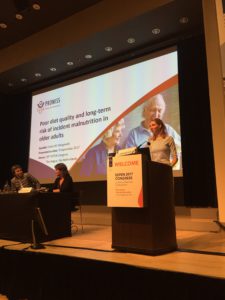
At the very well attended PROMISS symposium, which took place during the 39th ESPEN congress, our researchers presented their work on potential dietary risk factors for the development of malnutrition and on nutritional interventions to prevent malnutrition in community-dwelling older adults.
Thanks to a multi-disciplinary international consortium (23 partners from 11 countries), the PROMISS project is eager to:
- Provide insight in the causal links between diet, physical activity, appetite and malnutrition among older adults;
- Develop evidence-based dietary and physical activity strategies to prevent malnutrition and enhance active and healthy ageing;
- Deliver food concepts and products, as well as persuasive technology to support adherence to these strategies.
In this newsletter:
A sneak peek into PROMISS research
- The lower the protein intake, the greater the risk of developing mobility limitations
- Vary your activities and perform them regularly in order to age well!
- Towards new food products and concepts
What do older people think?
- Some opinions of experts, carers and seniors
What happens beyond research?
- The ESPEN congress on nutrition of older adults
- EFAD’s “Working together across health professions to combat malnutrition”
- EUGMS Congress and PROMISS General Assembly
Enjoy reading the first PROMISS newsletter here.
Houston DK, Tooze JA, Garcia K, Visser M, Rubin S, Harris TB, Newman AB, Kritchevsky SB; Health ABC Study.
J Am Geriatr Soc. 2017 Mar 17. doi: 10.1111/jgs.14856
In this study we investigated the protein intake of 1.998 older adults (70-79 years) who are living in the United States and who participate in the Health, Aging and Body Composition Study. On average, the older adults consumed 66.2 gram of protein per day. Of the men, 27.3% consumed less protein than the current Recommended Dietary Allowance, which indicates a consumption of at least 0.8 gram protein per kilogram of body weight. For women this was 26.5%.
All adults were well-functioning at baseline. The older adults were followed over 6 years, during which 45.5% developed a new mobility limitation, indicating they reported to experience difficulties walking one-quarter of a mile or climbing 10 steps without resting.
Older adults who consumed less than 0.70 grams of protein per kilogram of body weight at baseline, and those who consumed between 0.70 and 1.0 grams of protein per kilogram of body weight at baseline, were more likely to developed mobility limitation during the 6 years compared to older adults who consumed 1.0 or more grams of protein per kilogram body weight. These findings were similar when the animal protein consumption or the vegetable protein consumption were investigated separately.
The results of this research suggest that older adults with a lower protein intake are at greater risk of developing mobility limitations. They also suggest that consuming 1.0 or more grams of protein per kilogram body weight might be optimal for older persons to maintain physical function.
Read the whole scientific paper here.
Fluitman, K. S., De Clercq, N. C., Keijser, B. J. F., Visser, M., Nieuwdorp, M., & Ijzerman, R. G. (2017). The intestinal microbiota, energy balance, and malnutrition: emphasis on the role of short-chain fatty acids. Expert Review of Endocrinology & Metabolism, 12(3), 215-226. doi: 10.1080/17446651.2017.1318060
Over the last decades, increasing attention is being directed toward the vast amount of bacteria inhabiting the human gut: the intestinal microbiota.
These microbiota have been demonstrated to actively influence human energy balance.
Thus, a disruption of the normal microbiota can contribute to the development of malnutrition.
Accordingly, it was demonstrated that microbial composition differs between subjects with and without malnutrition.
This review of the literature summarizes the pathways through which the intestinal microbiota might contribute to malnutrition, how the microbiota differs in over- and undernutrion, and how the microbiota could be manipulated in a way to promote a healthy nutritional state.
Read the whole scientific paper here.
Dieses Projekt wird vom Forschungs- und Entwicklungsprogramm „Horizon 2020“ der Europäischen Union finanziell gefördert, Projektnummer: n° 678732. Der Inhalt der Webseite spiegelt allein die Sicht der Autoren wider – die Kommission kann nicht für den Inhalt verantwortlich gemacht werden.
Nu de Europese bevolking steeds ouder wordt, is de uitdaging om een toenemend aantal ouderen in alle Europese landen gezond en actief te houden. In Europa is tussen een vijfde en de helft van de thuiswonende ouderen ondervoed of loopt het risico op ondervoeding op het gebied van proteïne-energie. PROMISS is gericht op een beter begrip en uiteindelijk het voorkomen van ondervoeding op het gebied van proteïne-energie bij ouderen. Daarbij zal PROMISS bijdragen aan het verbeteren van actief en gezond ouder worden
The PROMISS leaflet is meant to introduce the audience to PROMISS activities and ambition, and let it become familiar with its content and visual identity. It is distributed during every relevant event organised by PROMISS partners, such as the EUGMS Congress, the EFAD conference, the ESPEN Conference, the AGE Platform Europe’s Annual Conference, and during external events where PROMISS is represented.
You can find it here.
Do not hesitate to share it as well!
This project has received funding from the European Union’s Horizon 2020 research and innovation programme, grant n° 678732.
The website’s content only reflects the author’s view and the Commission is not responsible for any use that may be made of the information it contains.
With the European population growing older, the challenge is to keep an increasing number of seniors across all European countries healthy and active. In Europe, between one fifth and half of all older adults living at home are malnourished or at risk of protein energy malnutrition. PROMISS aims to better understand and ultimately prevent protein energy malnutrition in seniors. Thereby, PROMISS will contribute to improve active and healthy ageing.
Last 6 and 7 June 2016, PROMISS partners gathered in Amsterdam, the Netherlands, to officially kick-off the project.
It was the occasion for partners to meet, exchange their views on PROMISS activities and officially start the work towards the first PROMISS deliverables.
We look forward to seeing PROMISS reach tangible results on how to prevent malnutrition among community-dwelling older adults. Keep an eye on the website and PROMISS social media accounts to learn about the project’s developments, and subscribe to the newsletters to directly receive regular updates.
Last February 2016, the European Innovation Partnership on Active and Healthy Ageing (EIP AHA) opened new calls inviting organisations to get involved in developing, promoting or deploying innovative solutions and ecosystems for active and healthy ageing. The Call for Commitments targeted innovative solutions for active and healthy ageing.
The call received a strong support. The European Commission has recorded over 850 commitments from 28 Member States (and beyond) while 78 Reference Site applications (from 22 Member States) were submitted, representing regional and national alliances of stakeholders invested in the scaling up of innovation for active and healthy ageing.
We are very happy that the commitment submitted by PROMISS has been accepted, letting us become one of the official members of the EIP AHA, and more precisely of the A3 action group on Functional decline and frailty.
